Paul van Yperen's Blog, page 373
August 21, 2015
Die Geyer-Wally (1921)
Henny Porten was one of the three brightest female stars of the silent Weimar cinema - the others were Asta Nielsen and Fern Andra. One of her success films was Die Geyer-Wally/Vulture Wally (E.A. Dupont, 1921), an atmospheric Alpine melodrama in which she played the free-spirited mountain girl Wally.
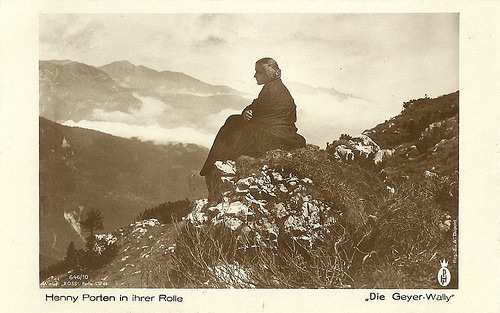
German postcard by Ross Verlag, no. 646/10. Photo: HPF (Henny Porten Film). Henny Porten as Wally in Die Geyer-Wally/Vulture Wally (E.A. Dupont, 1921).
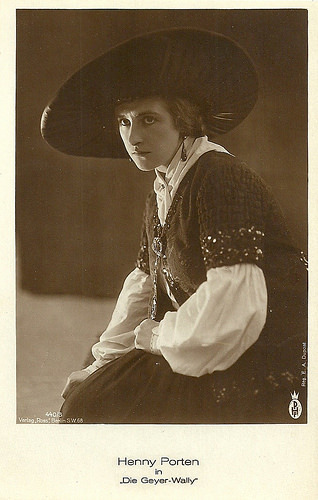
German postcard by Ross Verlag, no. 440/3. Photo: HPF (Henny Porten-Film). Henny Porten in Die Geyer-Wally/Vulture Wally (E.A. Dupont, 1921).
A difficult situation in a nest of vultures
Die Geyer-Wally/Vulture Wally is a 'bergfilm' (mountain film), a melodrama set in the Alps. It is based on a popular novel by Wilhelmine von Hillern.
When farmer daughter Wally ( Henny Porten ) saves Bären-Joseph from a difficult situation in a nest of vultures (Geier in German), she earns the nickname of Geier-Wally.
She falls in love with Bären-Joseph (Bear-Joseph - played by Wilhelm Dieterle a.k.a. Hollywood director William Dieterle) , but her father (Albert Steinrück) wants her to marry Der Gellner-Vincenz (Eugen Klöpfer).
Moreover, Joseph seems to have a secret lover. Wally is outraged when she learns about this and Vincenz even wants to kill him. But in the end it turns out that the 'lover' is Joseph's daughter, born out of wedlock. Wally and Joseph can still marry...
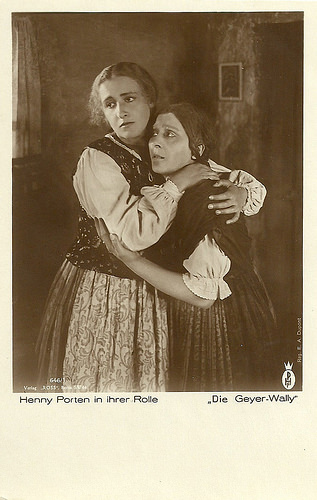
German postcard by Ross Verlag, no. 646/1. Photo: HPF (Henny Porten Film). Henny Porten as Wally in Die Geyer-Wally/Vulture Wally (E.A. Dupont, 1921). The second woman may be Maria Grimm-Einödshofer (Obermagd).
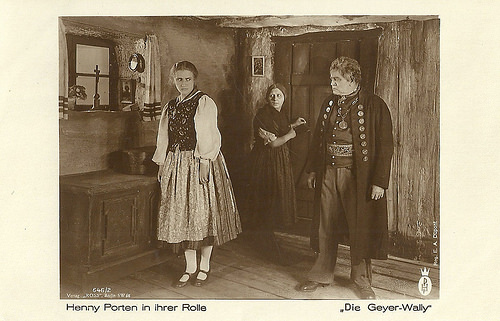
German postcard by Ross Verlag, no. 646/2. Photo: HPF (Henny Porten Film). Henny Porten as Wally in Die Geyer-Wally/Vulture Wally (E.A. Dupont, 1921). Albert Steinrück played her father, Stromminger. The second woman may be Maria Grimm-Einödshofer (Obermagd).
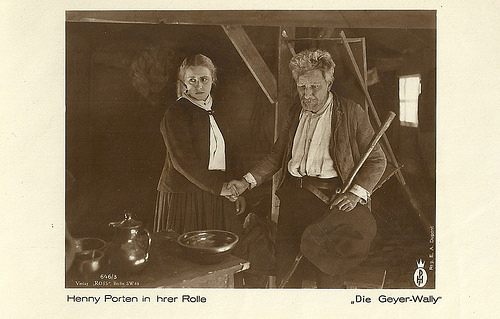
German postcard by Ross Verlag, no. 646/3. Photo: HPF (Henny Porten Film). Henny Porten as Wally in Die Geyer-Wally/Vulture Wally (E.A. Dupont, 1921). The man could be Julius Brandt (Klettenmeyer).
A huge box-office hit
Die Geyer-Wally/Vulture Wally is a typical 'bergfilm' (mountain film), an atmospheric mountain melodrama set in the Alps. In fact it was filmed in Garmisch-Partenkirchen in Bavaria.
Henny Porten was such a popular star at the time that she could produce the film herself. In 1919, Porten had founded her own film company, HPF (Henny Porten Film), which worked for Gloria-Film. The Ufa distributed the film.
Her production company had attracted an accomplished and talented cast and crew. Die Geier-Wally was directed by Ewald André Dupont, who would go on to direct the classic Variété/Variety (1925) and the sets were designed by Paul Leni, who would later become a horrorfilm director for Universal. In 1921, Leni co-directed her also in Hintertreppe/Backstairs (Paul Leni, Leopold Jessner, 1921).
Die Geyer-Wally/Vulture Wally was a huge box-office hit and one of Porten's most successful films of the early 1920s. The story was also the basis of Alfredo Catalani's opera La Wally. In 1930 followed a silent Italian film version, La leggenda di Wally (Gian Orlando Vassallo, 1930) featuring Linda Pini.
Sound versions included the Italian production La Wally (Guido Brignone, 1932) with Germana Paolieri , a second German version Die Geierwally (Hans Steinhoff, 1940) with Heidemarie Hatheyer , and a post-war version, riding the Heimatfilm wave Die Geierwally (Frantisek Cáp, 1956) with Barbara Rütting . Finally, Bavarian director Walter Bockmayer also made a spoof of the classic, Geierwally (1988).
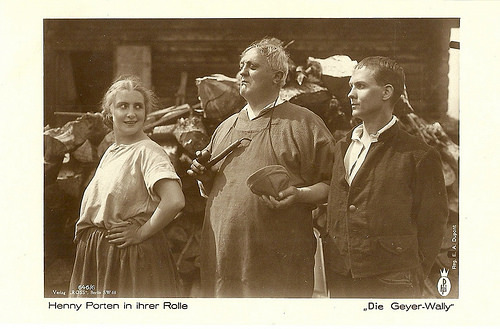
German postcard by Ross Verlag, no. 646/6. Photo: HPF (Henny Porten Film). Henny Porten as Wally in Die Geyer-Wally/Vulture Wally (E.A. Dupont, 1921). Despite the fact that drama and romance dominate, the film has some witty scenes, sich as the one in which Wally rejects the marriage proposal by farmer Rosenbauer senior (Wilhelm Diegelmann) and his son Rosenbauer junior (Gerd Fricke).
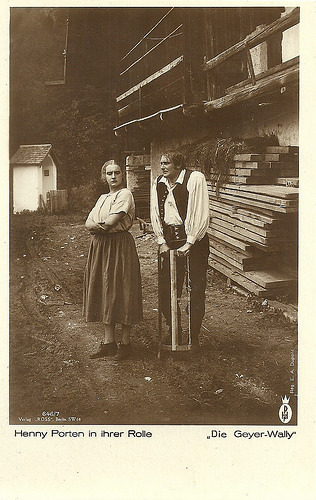
German postcard by Ross Verlag, no. 646/7. Photo: HPF (Henny Porten Film). Henny Porten as Wally and Eugen Klöpfer as Vincenz in Die Geyer-Wally/Vulture Wally (E.A. Dupont, 1921).
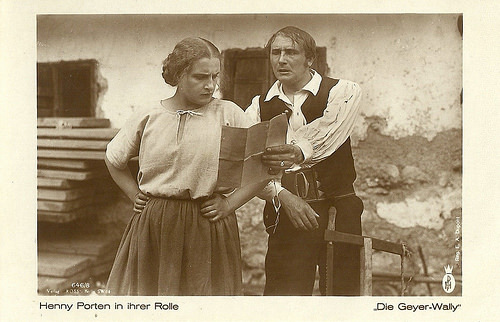
German postcard by Ross Verlag, no. 646/8. Photo: HPF (Henny Porten Film). Henny Porten as Wally and Eugen Klöpfer as Vincenz in Die Geyer-Wally/Vulture Wally (E.A. Dupont, 1921).
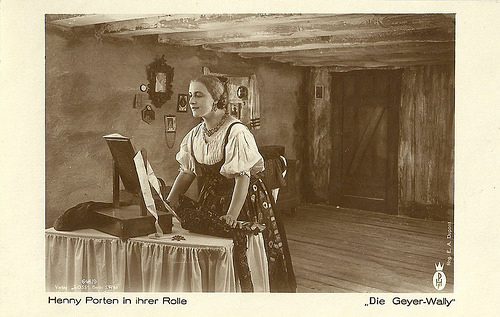
German postcard by Ross Verlag, no. 646/9. Photo: HPF (Henny Porten Film). Henny Porten as Wally in Die Geyer-Wally/Vulture Wally (E.A. Dupont, 1921).
Die Geyer-Wally/Vulture Wally (1921). Source: Paul Greif (YouTube).
Sources: Filmportal.de (German), Wikipedia and IMDb.

German postcard by Ross Verlag, no. 646/10. Photo: HPF (Henny Porten Film). Henny Porten as Wally in Die Geyer-Wally/Vulture Wally (E.A. Dupont, 1921).

German postcard by Ross Verlag, no. 440/3. Photo: HPF (Henny Porten-Film). Henny Porten in Die Geyer-Wally/Vulture Wally (E.A. Dupont, 1921).
A difficult situation in a nest of vultures
Die Geyer-Wally/Vulture Wally is a 'bergfilm' (mountain film), a melodrama set in the Alps. It is based on a popular novel by Wilhelmine von Hillern.
When farmer daughter Wally ( Henny Porten ) saves Bären-Joseph from a difficult situation in a nest of vultures (Geier in German), she earns the nickname of Geier-Wally.
She falls in love with Bären-Joseph (Bear-Joseph - played by Wilhelm Dieterle a.k.a. Hollywood director William Dieterle) , but her father (Albert Steinrück) wants her to marry Der Gellner-Vincenz (Eugen Klöpfer).
Moreover, Joseph seems to have a secret lover. Wally is outraged when she learns about this and Vincenz even wants to kill him. But in the end it turns out that the 'lover' is Joseph's daughter, born out of wedlock. Wally and Joseph can still marry...

German postcard by Ross Verlag, no. 646/1. Photo: HPF (Henny Porten Film). Henny Porten as Wally in Die Geyer-Wally/Vulture Wally (E.A. Dupont, 1921). The second woman may be Maria Grimm-Einödshofer (Obermagd).

German postcard by Ross Verlag, no. 646/2. Photo: HPF (Henny Porten Film). Henny Porten as Wally in Die Geyer-Wally/Vulture Wally (E.A. Dupont, 1921). Albert Steinrück played her father, Stromminger. The second woman may be Maria Grimm-Einödshofer (Obermagd).

German postcard by Ross Verlag, no. 646/3. Photo: HPF (Henny Porten Film). Henny Porten as Wally in Die Geyer-Wally/Vulture Wally (E.A. Dupont, 1921). The man could be Julius Brandt (Klettenmeyer).
A huge box-office hit
Die Geyer-Wally/Vulture Wally is a typical 'bergfilm' (mountain film), an atmospheric mountain melodrama set in the Alps. In fact it was filmed in Garmisch-Partenkirchen in Bavaria.
Henny Porten was such a popular star at the time that she could produce the film herself. In 1919, Porten had founded her own film company, HPF (Henny Porten Film), which worked for Gloria-Film. The Ufa distributed the film.
Her production company had attracted an accomplished and talented cast and crew. Die Geier-Wally was directed by Ewald André Dupont, who would go on to direct the classic Variété/Variety (1925) and the sets were designed by Paul Leni, who would later become a horrorfilm director for Universal. In 1921, Leni co-directed her also in Hintertreppe/Backstairs (Paul Leni, Leopold Jessner, 1921).
Die Geyer-Wally/Vulture Wally was a huge box-office hit and one of Porten's most successful films of the early 1920s. The story was also the basis of Alfredo Catalani's opera La Wally. In 1930 followed a silent Italian film version, La leggenda di Wally (Gian Orlando Vassallo, 1930) featuring Linda Pini.
Sound versions included the Italian production La Wally (Guido Brignone, 1932) with Germana Paolieri , a second German version Die Geierwally (Hans Steinhoff, 1940) with Heidemarie Hatheyer , and a post-war version, riding the Heimatfilm wave Die Geierwally (Frantisek Cáp, 1956) with Barbara Rütting . Finally, Bavarian director Walter Bockmayer also made a spoof of the classic, Geierwally (1988).

German postcard by Ross Verlag, no. 646/6. Photo: HPF (Henny Porten Film). Henny Porten as Wally in Die Geyer-Wally/Vulture Wally (E.A. Dupont, 1921). Despite the fact that drama and romance dominate, the film has some witty scenes, sich as the one in which Wally rejects the marriage proposal by farmer Rosenbauer senior (Wilhelm Diegelmann) and his son Rosenbauer junior (Gerd Fricke).

German postcard by Ross Verlag, no. 646/7. Photo: HPF (Henny Porten Film). Henny Porten as Wally and Eugen Klöpfer as Vincenz in Die Geyer-Wally/Vulture Wally (E.A. Dupont, 1921).

German postcard by Ross Verlag, no. 646/8. Photo: HPF (Henny Porten Film). Henny Porten as Wally and Eugen Klöpfer as Vincenz in Die Geyer-Wally/Vulture Wally (E.A. Dupont, 1921).

German postcard by Ross Verlag, no. 646/9. Photo: HPF (Henny Porten Film). Henny Porten as Wally in Die Geyer-Wally/Vulture Wally (E.A. Dupont, 1921).
Die Geyer-Wally/Vulture Wally (1921). Source: Paul Greif (YouTube).
Sources: Filmportal.de (German), Wikipedia and IMDb.
Published on August 21, 2015 22:00
August 20, 2015
Peter Alexander
Peter Alexander (1926-2011) was an Austrian film actor and schlager- and operetta singer. He became popular in the 1950s and 1960s with his numerous roles in German musical comedies.
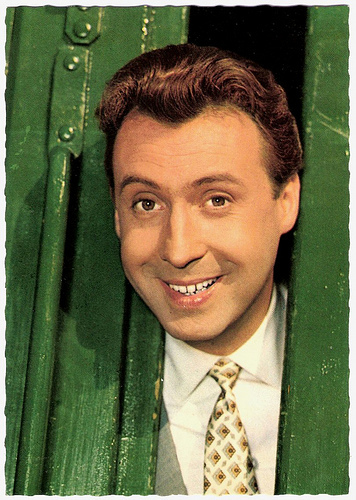
German postcard by ISV, no. H 142.
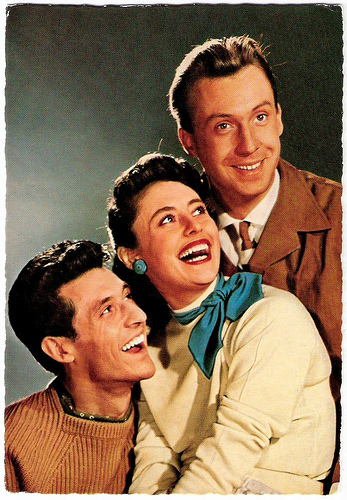
German postcard by WS-Druck, Wanne-Eickel, no. F 73. Photo: Lantin.
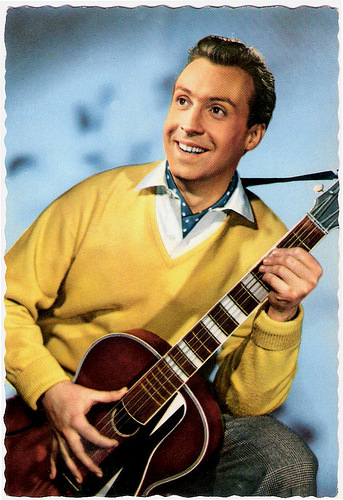
Belgian postcard by Edition H. Troukens, Hofstade, no. 1028. Photo: Ufa.
Prisoner-of-War
Peter Alexander was born in 1926 as Peter Alexander Ferdinand Maximilian Neumayer in Vienna, Austria. During World War II, he was a member of the Luftwaffenhelfer and the Reichsarbeitsdienst before being drafted into the navy. In 1945, he was captured by the British and held as a prisoner-of-war.
After the war he attended Vienna's Max Reinhardt Seminary until 1948 and then started a career as an actor. His first film appearance was an uncredited bit part in Der Engel mit der Posaune/The Angel with the Trumpet (Karl Hartl, 1948).
In 1951 Alexander released his first record, Das machen nur die Beine von Dolores, which reached the hit parade. Till 1982 there would be another 40 Top 10 hits and he sold a total of 46 million records.
From 1952 on he appeared as a singer in films like Verlorene Melodie/Vanished Melody (Eduard von Borsody, 1952), Salto Mortale (Viktor Tourjansky, 1953), and Die Große Starparade/The Big Star Parade (Paul Martin, 1954).
In 1953 he won the contest Deutschen Musikwettbewerb in München (Munich) before Vico Torriani and Gerhard Wendland.
The next year he starred with Caterina Valente and Silvio Francesco in the musical comedy Liebe, Tanz und 1000 Schlager/Love, Dance, and 1000 Songs (Paul Martin, 1955). The threesome appeared again in Bonjour Kathrin (Karl Anton, 1956).
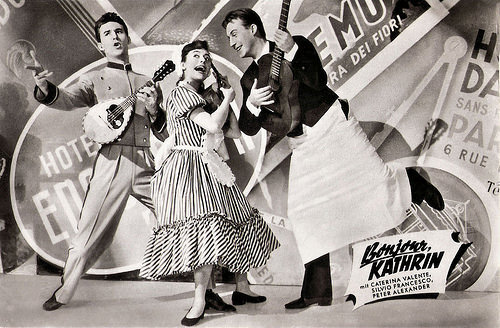
East-German postcard by VEB Progress Film-Vertrieb, no. 164, 1956. Retail price: 0,20 DM. Photo: publicity still for Bonjour, Kathrin (Karl Anton, 1956) with Caterina Valente and Silvio Francesco.
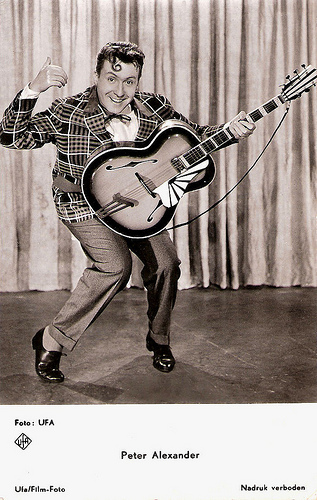
Dutch postcard by Gebr. Spanjersberg N.V., Rotterdam, no. 1222. Photo: Ufa.
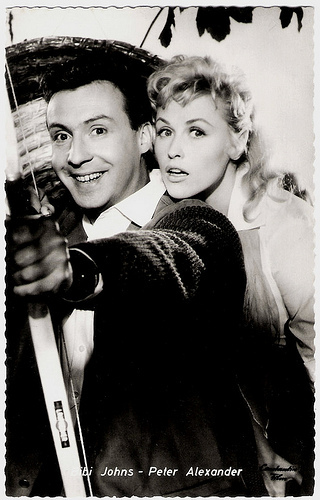
German postcard by Kolibri-Verlag, Minden/Westf., no. 399. Photo: Arthur Grimm / CCC / Constantin. Publicity still for Wehe, wenn sie losgelassen/Beware when she is released (Géza von Cziffra, 1958).
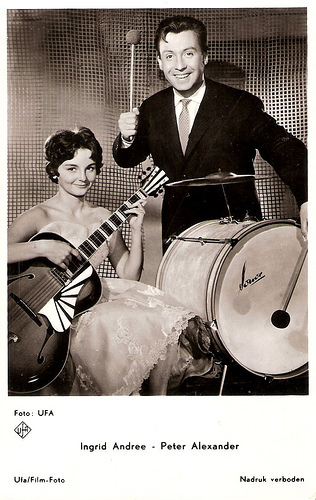
Dutch postcard by Gebr. Spanjersberg N.V., Rotterdam, no. 1218/459. Photo: UFA (Universum-Film Aktiengesellschaft, Berlin-Tempelhof). This is obviously a publicity still for the comedy Schlag auf Schlag/Blow On Blow (Géza von Cziffra, 1959) which starred Peter Alexander, Wolfgang Wahl, Ralf Wolter , and Ingrid Andree .
Count Bobby Pinelski
In the following decades Peter Alexander made some 30 entertainment films, including Ein Mann muß nicht immer schön sein/A Man Doesn't Always Need to Be Handsome (Hans Quest, 1956), Münchhausen in Afrika (Werner Jacobs, 1958), Peter schießt den Vogel ab/Peter Shoots the Bird (Géza von Cziffra, 1959), the operetta film Im weißen Rößl/The White Horse Inn (Werner Jacobs, 1960), the fine Jaroslav Hasek adaptation Schwejks Flegeljahre/Schweik's Years of Indiscretion (Wolfgang Liebeneiner, 1963), and Hilfe, meine Braut klaut/Help, My Bride Steals (Werner Jacobs, 1964) opposite Conny Froboess.
Günther Philipp was often his partner in these films. In the 1960s Peter Alexander also starred in the popular Count Bobby Pinelski films, like Die Abenteuer des Grafen Bobby/The Adventures of Count Bobby (Géza von Cziffra, 1961) with Vivi Bach, and the silly Luemmel-series, like Hurra, die Schule brennt/Hurrah, the School Is Burning (Werner Jacobs, 1969) with Dutch child star Heintje Simons.
In 1969, Peter Alexander started a second career as a TV host, with the Peter Alexander Show. He is considered Austria`s most popular entertainer of the 1970s and 1980s. He was famous for his parodies, including Queen Elizabeth II, and the four leading characters of the TV series The Golden Girls.
In 1952 Peter Alexander had married actress Hilde Haagen, who became his manager. The couple had two children, Susanne and Michael. Since the death of his wife in 2003, he has lived in his house in Vienna, completely retired from the public. His daughter, the artist Susanne Neumayer-Haidinger, passed away in 2009. Peter Alexander died in 2011, aged 84, in his native Vienna. He was survived by his son and two grandchildren.
Trailer Kriminaltango (Géza von Cziffra, 1960). Source: Arild Rafalzik (YouTube).
Schwejks Flegeljahre/Schweik's Years of Indiscretion (1963). Source: Fritz 51166 (YouTube).
Trailer of Hilfe, meine Braut klaut (1964) with Conny Froboess and Peter Alexander. Source: Conny Froboess (YouTube).
Trailer for Hauptsache Ferien (1972). Source: Rialto Film (YouTube).
Sources: Wikipedia and .

German postcard by ISV, no. H 142.

German postcard by WS-Druck, Wanne-Eickel, no. F 73. Photo: Lantin.

Belgian postcard by Edition H. Troukens, Hofstade, no. 1028. Photo: Ufa.
Prisoner-of-War
Peter Alexander was born in 1926 as Peter Alexander Ferdinand Maximilian Neumayer in Vienna, Austria. During World War II, he was a member of the Luftwaffenhelfer and the Reichsarbeitsdienst before being drafted into the navy. In 1945, he was captured by the British and held as a prisoner-of-war.
After the war he attended Vienna's Max Reinhardt Seminary until 1948 and then started a career as an actor. His first film appearance was an uncredited bit part in Der Engel mit der Posaune/The Angel with the Trumpet (Karl Hartl, 1948).
In 1951 Alexander released his first record, Das machen nur die Beine von Dolores, which reached the hit parade. Till 1982 there would be another 40 Top 10 hits and he sold a total of 46 million records.
From 1952 on he appeared as a singer in films like Verlorene Melodie/Vanished Melody (Eduard von Borsody, 1952), Salto Mortale (Viktor Tourjansky, 1953), and Die Große Starparade/The Big Star Parade (Paul Martin, 1954).
In 1953 he won the contest Deutschen Musikwettbewerb in München (Munich) before Vico Torriani and Gerhard Wendland.
The next year he starred with Caterina Valente and Silvio Francesco in the musical comedy Liebe, Tanz und 1000 Schlager/Love, Dance, and 1000 Songs (Paul Martin, 1955). The threesome appeared again in Bonjour Kathrin (Karl Anton, 1956).

East-German postcard by VEB Progress Film-Vertrieb, no. 164, 1956. Retail price: 0,20 DM. Photo: publicity still for Bonjour, Kathrin (Karl Anton, 1956) with Caterina Valente and Silvio Francesco.

Dutch postcard by Gebr. Spanjersberg N.V., Rotterdam, no. 1222. Photo: Ufa.

German postcard by Kolibri-Verlag, Minden/Westf., no. 399. Photo: Arthur Grimm / CCC / Constantin. Publicity still for Wehe, wenn sie losgelassen/Beware when she is released (Géza von Cziffra, 1958).

Dutch postcard by Gebr. Spanjersberg N.V., Rotterdam, no. 1218/459. Photo: UFA (Universum-Film Aktiengesellschaft, Berlin-Tempelhof). This is obviously a publicity still for the comedy Schlag auf Schlag/Blow On Blow (Géza von Cziffra, 1959) which starred Peter Alexander, Wolfgang Wahl, Ralf Wolter , and Ingrid Andree .
Count Bobby Pinelski
In the following decades Peter Alexander made some 30 entertainment films, including Ein Mann muß nicht immer schön sein/A Man Doesn't Always Need to Be Handsome (Hans Quest, 1956), Münchhausen in Afrika (Werner Jacobs, 1958), Peter schießt den Vogel ab/Peter Shoots the Bird (Géza von Cziffra, 1959), the operetta film Im weißen Rößl/The White Horse Inn (Werner Jacobs, 1960), the fine Jaroslav Hasek adaptation Schwejks Flegeljahre/Schweik's Years of Indiscretion (Wolfgang Liebeneiner, 1963), and Hilfe, meine Braut klaut/Help, My Bride Steals (Werner Jacobs, 1964) opposite Conny Froboess.
Günther Philipp was often his partner in these films. In the 1960s Peter Alexander also starred in the popular Count Bobby Pinelski films, like Die Abenteuer des Grafen Bobby/The Adventures of Count Bobby (Géza von Cziffra, 1961) with Vivi Bach, and the silly Luemmel-series, like Hurra, die Schule brennt/Hurrah, the School Is Burning (Werner Jacobs, 1969) with Dutch child star Heintje Simons.
In 1969, Peter Alexander started a second career as a TV host, with the Peter Alexander Show. He is considered Austria`s most popular entertainer of the 1970s and 1980s. He was famous for his parodies, including Queen Elizabeth II, and the four leading characters of the TV series The Golden Girls.
In 1952 Peter Alexander had married actress Hilde Haagen, who became his manager. The couple had two children, Susanne and Michael. Since the death of his wife in 2003, he has lived in his house in Vienna, completely retired from the public. His daughter, the artist Susanne Neumayer-Haidinger, passed away in 2009. Peter Alexander died in 2011, aged 84, in his native Vienna. He was survived by his son and two grandchildren.
Trailer Kriminaltango (Géza von Cziffra, 1960). Source: Arild Rafalzik (YouTube).
Schwejks Flegeljahre/Schweik's Years of Indiscretion (1963). Source: Fritz 51166 (YouTube).
Trailer of Hilfe, meine Braut klaut (1964) with Conny Froboess and Peter Alexander. Source: Conny Froboess (YouTube).
Trailer for Hauptsache Ferien (1972). Source: Rialto Film (YouTube).
Sources: Wikipedia and .
Published on August 20, 2015 22:00
August 19, 2015
Claudio Ermelli
Italian film actor Claudio Ermelli (1892-1964) played bit parts and character roles in more than 115 films, from 1915 to 1962.
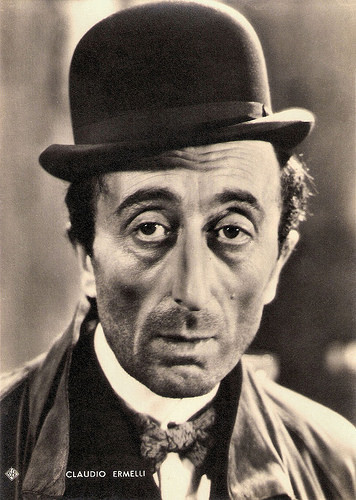
Italian postcard by ASER, Roma, no. 97. Photo: Pesce.
Mad Animals
Claudio Ermelli was born Ettore Foa in Turin, Italy in 1892. He was born into a family of Jewish origin. He followed in the footsteps of his physician father and joined the Faculty of Medicine. Then he interrupted his studies to pursue his true passion: the theatre and acting.
In 1915 he made his film debut in a supporting part as a sacristan in the silent short Silvio e lo Stradivarius/Silvio and the stradivarius (Ugo Falena, 1915), produced by Film d'Arte Italiana. In the 1990s this touching melodrama about an orphan boy (actress Silvia Malinverni) who loses his favourite violin, was discovered in the archive of the Dutch Filmmuseum.
After this film debut, Ermelli returned to the stage and became the manager of his own vaudeville company. After a long interval, he returned to the cinema in sound films like the comedy Zaganella e il cavaliere/Zaganella and the knight (Giorgio Mannini, Gustavo Serena, 1932) with Arturo Falconi and Marcella Albani , and Il dono del mattino/The gift of the morning (Enrico Guazzoni, 1932) with Germana Paolieri . In these films he always played character roles.
Throughout the 1930s, Ermelli played supporting parts in films like the comedy L'antenato/The Ancestor (Guido Brignone, 1936), starring Antonio Gandusio and Paola Barbara , the successful historical drama Il dottor Antonio/Doctor Antonio (Enrico Guazzoni, 1937), and the comedy I fratelli Castiglioni/The Castiglioni Brothers (Corrado D'Errico, 1937), starring Camillo Pilotto and Amedeo Nazzari . He also appeared with Totò in the comedy Animali pazzi/Mad Animals (Carlo Ludovico Bragaglia, 1939).
Although of Jewish origin, Ermelli never had problems, even after the racial laws of 1938. He continued playing supporting parts and small roles during the war years. Among his films were the drama La forza bruta/Brute Force (Carlo Ludovico Bragaglia 1941) with Juan de Landa and Rossano Brazzi, the comedy L'elisir d'amore (Amleo Palermi, 1941) with Arturo Falconi, and the Totò comedy Due cuori fra le belve/Two hearts among the beasts (Giorgio Simonelli, 1943).
The best known film of this period is Tosca (Jean Renoir, Carl Koch, 1941) in which Ermelli played the composer and director Paisiello, who despairs when Tosca ( Imperio Argentina ) repeatedly interrupts his repetitions for a royal performance.
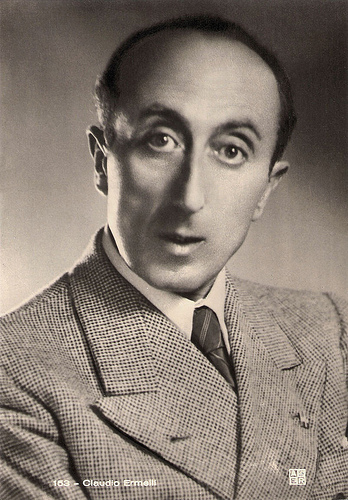
Italian postcard by ASER (A. Scaramiglia Edizioni, Roma), no. 163. Photographer unknown.
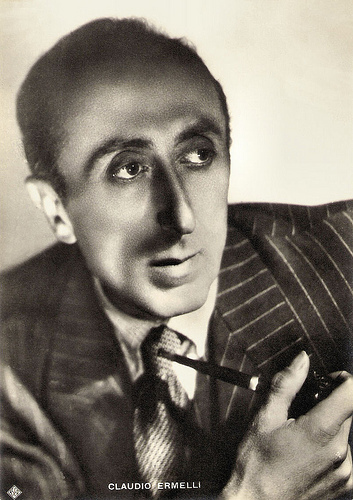
Italian postcard by ASER (A. Scaramiglia Edizioni, Roma). Photo: Fotopan.
Roman Holdiday
After the war, Claudio Ermelli often appeared on stage productions by directors like Luchino Visconti, Luciano Mondolfo and Luigi Squarzina.
On the screen he was seen in Sperduti nel buio/Lost in the Dark (Camillo Mastrocinque, 1947), which starred Vittorio De Sica . This Italian drama, based on a play by Roberto Bracco, was entered into the 1947 Cannes Film Festival. In 1914, it had already been made into a now lost silent film by Nino Martoglio with sets designed by the futurist architect Virgilio Marchi and with Maria Carmi as one of the stars.
One of Ermelli’s best known post-war films is the delicious romantic comedy Roman Holliday (William Wyler, 1953), with Audrey Hepburn as a royal princess out to see Rome on her own. She is guided by undercover journalist Gregory Peck. The film was shot at the Cinecittà studios and on location around Rome. Ermelli played Peck’s Italian neighbour Giovanni. Hilarious is the scene in which Peck lends some money to Hepburn for a taxi while Giovanni looks on, growing more and more convinced that he’s paying her for the night they spent together.
Ermelli played another funny character role in the American romantic comedy It Started in Naples (Melville Shavelson, 1960) with Clark Gable, Sophia Loren , and an Italian cast. His last screen appearance was in the TV series Una tragedia Americana/An American Tragedy (Anton Giulio Majano, 1962) with Virna Lisi .
Claudio Ermelli died in 1964 in Rome. He was 72.
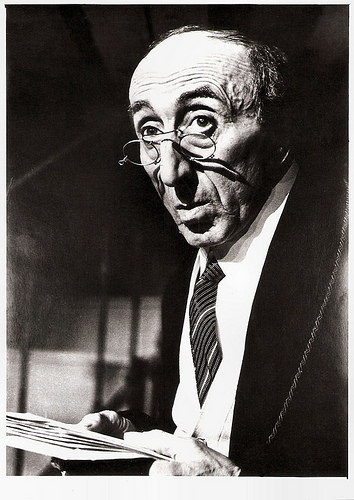
Vintage photo.
Source: Vittorio Martinelli (Il Cinema Muto Italiana 1915 II - Italian), AllMovie, Wikipedia (Italian and English) and .

Italian postcard by ASER, Roma, no. 97. Photo: Pesce.
Mad Animals
Claudio Ermelli was born Ettore Foa in Turin, Italy in 1892. He was born into a family of Jewish origin. He followed in the footsteps of his physician father and joined the Faculty of Medicine. Then he interrupted his studies to pursue his true passion: the theatre and acting.
In 1915 he made his film debut in a supporting part as a sacristan in the silent short Silvio e lo Stradivarius/Silvio and the stradivarius (Ugo Falena, 1915), produced by Film d'Arte Italiana. In the 1990s this touching melodrama about an orphan boy (actress Silvia Malinverni) who loses his favourite violin, was discovered in the archive of the Dutch Filmmuseum.
After this film debut, Ermelli returned to the stage and became the manager of his own vaudeville company. After a long interval, he returned to the cinema in sound films like the comedy Zaganella e il cavaliere/Zaganella and the knight (Giorgio Mannini, Gustavo Serena, 1932) with Arturo Falconi and Marcella Albani , and Il dono del mattino/The gift of the morning (Enrico Guazzoni, 1932) with Germana Paolieri . In these films he always played character roles.
Throughout the 1930s, Ermelli played supporting parts in films like the comedy L'antenato/The Ancestor (Guido Brignone, 1936), starring Antonio Gandusio and Paola Barbara , the successful historical drama Il dottor Antonio/Doctor Antonio (Enrico Guazzoni, 1937), and the comedy I fratelli Castiglioni/The Castiglioni Brothers (Corrado D'Errico, 1937), starring Camillo Pilotto and Amedeo Nazzari . He also appeared with Totò in the comedy Animali pazzi/Mad Animals (Carlo Ludovico Bragaglia, 1939).
Although of Jewish origin, Ermelli never had problems, even after the racial laws of 1938. He continued playing supporting parts and small roles during the war years. Among his films were the drama La forza bruta/Brute Force (Carlo Ludovico Bragaglia 1941) with Juan de Landa and Rossano Brazzi, the comedy L'elisir d'amore (Amleo Palermi, 1941) with Arturo Falconi, and the Totò comedy Due cuori fra le belve/Two hearts among the beasts (Giorgio Simonelli, 1943).
The best known film of this period is Tosca (Jean Renoir, Carl Koch, 1941) in which Ermelli played the composer and director Paisiello, who despairs when Tosca ( Imperio Argentina ) repeatedly interrupts his repetitions for a royal performance.

Italian postcard by ASER (A. Scaramiglia Edizioni, Roma), no. 163. Photographer unknown.

Italian postcard by ASER (A. Scaramiglia Edizioni, Roma). Photo: Fotopan.
Roman Holdiday
After the war, Claudio Ermelli often appeared on stage productions by directors like Luchino Visconti, Luciano Mondolfo and Luigi Squarzina.
On the screen he was seen in Sperduti nel buio/Lost in the Dark (Camillo Mastrocinque, 1947), which starred Vittorio De Sica . This Italian drama, based on a play by Roberto Bracco, was entered into the 1947 Cannes Film Festival. In 1914, it had already been made into a now lost silent film by Nino Martoglio with sets designed by the futurist architect Virgilio Marchi and with Maria Carmi as one of the stars.
One of Ermelli’s best known post-war films is the delicious romantic comedy Roman Holliday (William Wyler, 1953), with Audrey Hepburn as a royal princess out to see Rome on her own. She is guided by undercover journalist Gregory Peck. The film was shot at the Cinecittà studios and on location around Rome. Ermelli played Peck’s Italian neighbour Giovanni. Hilarious is the scene in which Peck lends some money to Hepburn for a taxi while Giovanni looks on, growing more and more convinced that he’s paying her for the night they spent together.
Ermelli played another funny character role in the American romantic comedy It Started in Naples (Melville Shavelson, 1960) with Clark Gable, Sophia Loren , and an Italian cast. His last screen appearance was in the TV series Una tragedia Americana/An American Tragedy (Anton Giulio Majano, 1962) with Virna Lisi .
Claudio Ermelli died in 1964 in Rome. He was 72.

Vintage photo.
Source: Vittorio Martinelli (Il Cinema Muto Italiana 1915 II - Italian), AllMovie, Wikipedia (Italian and English) and .
Published on August 19, 2015 22:00
August 18, 2015
Imported from the USA: Gordon Scott
Good-looking and muscular American actor Gordon Scott (1926–2007) is best known as the eleventh Tarzan. He portrayed Tarzan in five films from 1955 to 1960. Then Scott moved to Italy, where he became a popular star of the Peplum film genre, the sword-and-sandal epics. As the Peplum faded, Scott starred in Spaghetti Westerns and Eurospy films.

German collectors card by J & M Serienbilder Produktion Saar, no. 68. Photo: Gloria Film. Publicity still for Buffalo Bill, l'eroe del far west/Buffalo Bill, Hero of the Far West (Mario Costa, 1965). Caption: "In einem Zweikampf auf Leben und Tod hat Buffalo Bill, der berühmteste Held des Wilden Westens, seinen gefährlichsten Feind bezwungen. Der edle Kämpfer schenkt seinem Gegner das Leben. Die Indianer selbst sollen seine Strafe bestimmen." (In a duel to the death, Buffalo Bill, the famous hero of the Wild West, has defeated his most dangerous enemy. The noble warrior gives his opponent his life. The Indians themselves have to determine his punishment.)
Handsome features, muscular physique, and imposing height
Gordon Scott was born Gordon Merrill Werschkul in Portland, Oregon, in 1926. He was one of nine children of advertising man Stanley Werschkul and his wife Alice. He was raised in Oregon and studied Physical Education at the University of Oregon for one semester.
Upon leaving school, he joined the U.S. Army in 1944. He served as a drill sergeant and military policeman, and specialized in close order drill, judo and hand-to-hand combat. After his honourable discharge in 1947 he took on a variety of jobs, including fireman, cowboy, and farm-machinery salesman. In 1953 he was working as a lifeguard at the Sahara Hotel in Las Vegas when he was spotted by Hollywood agents, Ed and Walter Mayers. They were impressed by his handsome features, muscular physique, and imposing height.
Scott then beat out 200 contestants to replace Lex Barker as Edgar Rice Burroughs' famous jungle hero Tarzan. Film producer Sol Lesser offered him a 7 year contract, a loin cloth and a new last name. Reportedly, ‘Werschkul’ sounded too much like ‘Weissmuller’. So as Gordon Scott, he debuted in the low-budget Tarzan’s Hidden Jungle (Harold D. Schuster, 1955).
It led to a romance with co-star Vera Miles, who became his wife in 1956. They divorced in 1959. Tarzan’s Hidden Jungle was followed by Tarzan and the Lost Safari (H. Bruce Humberstone, 1957), the first Tarzan film in colour. It was filmed in Nairobi, British East Africa. In his early Tarzan films, Scott played the character as unworldly and inarticulate, in the mold of Johnny Weissmuller.
In 1958, Sol Lesser sold Scott's contract to Sy Weintraub. The new producer took his star to Paramount Pictures and, fueled by bigger production budgets, made two of the most successful Tarzan films, Tarzan's Greatest Adventure (John Guillermin, 1959) with Anthony Quayle and Sean Connery, and Tarzan the Magnificent (Robert Day, 1960) with Jock Mahoney. In these later films, Scott played a Tarzan who was educated and spoke perfect English, as in the original Edgar Rice Burroughs novels. Gordon Scott was the only actor to play Tarzan in both styles.
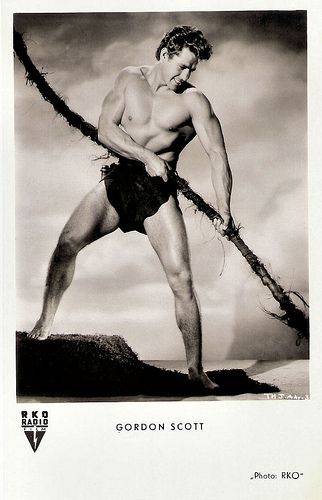
German postcard by Kunst und Bild, no. I 411. Photo: RKO. Publicity still for Tarzan's Hidden Jungle (Harold D. Schuster, 1955).
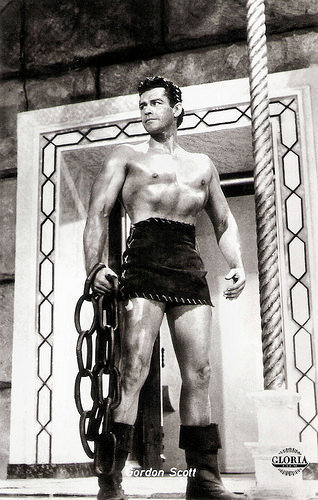
German postcard by Kolibri/Friedrich W. Sander-Verlag, Minden/Westf., no. 2322. Photo: Gloria Film. Publicity still for Maciste contro il vampiro/Maciste Vs. the Vampire (Giacomo Gentilomo, 1961).
Sword-and-sandal epics
Fearing he would become typecast as Tarzan, Gordon Scott moved to Italy. There he became a popular star of the Peplum genre, the sword-and-sandal epics featuring handsome bodybuilders as various characters from Greek and Roman myth.
Scott was an old training buddy of Hercules star Steve Reeves. Reeves had agreed to star in the Sergio Leone-penned saga Romolo e Remo/Duel of the Titans (Sergio Corbucci, 1961) about the two brothers of Roman Mythology, who founded Rome. The producer wanted Reeves to play both Romulus and Remus, but Reeves objected that the film would be more effective with another actor in the role of Remus. He recommended Gordon Scott, and the film co-starred Virna Lisi , Laura Solari, Massimo Girotti and Jacques Sernas . Scott was given the highest salary he had earned thus far for taking the role.
Next followed Maciste alla corte del Gran Khan/Maciste at the Court of the Great Khan (Riccardo Freda, 1961), which re-used the sets, extras and Yoko Tani as a princess from Marco Polo (Piero Pierotti, Hugo Fregonese, 1961) and Freda's I mongoli/The Mongols (André De Toth, Leopoldo Savona, Riccardo Freda, 1961).
Scott played Julius Caesar opposite Pascale Petit as Cleopatra in the historical drama Una regina per Cesare/A Queen for Caesar (Piero Pierotti, Victor Tourjansky, 1962) set in Egypt in 48 BC. Unlike other films about Caesar and Cleopatra, this film focuses entirely on the dynastic struggle within Egypt leading up to the arrival of Caesar, and in fact, we only see him in the closing scene of the film when he arrives at The Ptolemaic Palace in Alexandria. 20th Century Fox bought the rights for the film to keep it out of release lest it compete with their own Cleopatra, featuring Elizabeth Taylor. Scott also played Hercules in a couple of international co-productions during the mid-1960s.
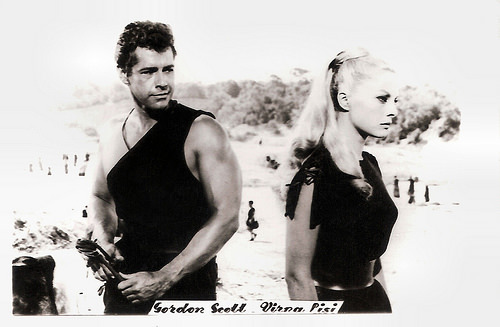
Small Romanian collectors card. Photo: publicity still for Romolo e Remo/Duel of the Titans (Sergio Corbucci, 1961).
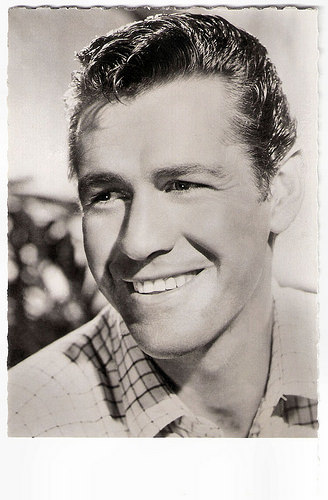
Vintage postcard.
Buffalo Bill
As the Peplum genre faded, Gordon Scott starred in other genre films. His first Spaghetti Western was Buffalo Bill, l'eroe del far west/Buffalo Bill, Hero of the Far West (Mario Costa, 1964) with Jan Hendriks .
He also starred in the Eurospy film Il Raggio infernale/Danger!! Death Ray (Gianfranco Baldanello, 1967), released at a time when the James Bond films, and spy films in general, were very popular internationally. His early military combat and martial arts training made it possible for him to do many of his own stunts.
His final film appearance was in the Spaghetti Western Gli uomini dal passo pesante/The Tramplers (Albert Band, Mario Sequi, 1966-1968) with Joseph Cotten and Franco Nero. He left Italy, and never made another film. He was trailed by a reputation as a ladies' man who seldom paid his bills, according to a 1987 article in the Toronto Star. For the last two decades of his life, Scott was a popular guest at film conventions and autograph shows and sold knives.
In 2007, Gordon Scott died, aged 80, in Baltimore, Maryland, of lingering complications from multiple heart surgeries earlier in the year. Adam Bernstein in his obituary in The Washington Post: “He lived with a series of obliging friends and ‘Tarzan’ fans, most recently in Baltimore. He had a troubled marriage to Miles, who apparently was under the impression that she was his first wife. She was his second or third, by varying accounts. He was seldom in contact with his surviving family, which includes a brother and two sisters. He had a son with Miles, and it's unclear how many other children he might have had. He was estranged from nearly everyone.”
Scott was married three times. His first marriage was with Janice Mae Wynkoop, of Oakland, California. They met when he was a lifeguard at Lake Temescal, located in Oakland, California. The couple married in Reno, Nevada, in 1948, and had one child, Karen Judith Werschkul (1948), before divorcing in 1949. His second marriage was to a woman he met while they were both working at the Sahara Hotel in Las Vegas. Gordon as a lifeguard and his wife as a PBX operator. They soon married and had a son, Eric, but the marriage ended once Gordon's acting career took off. With Vera Miles, he had one son, Michael (1957).
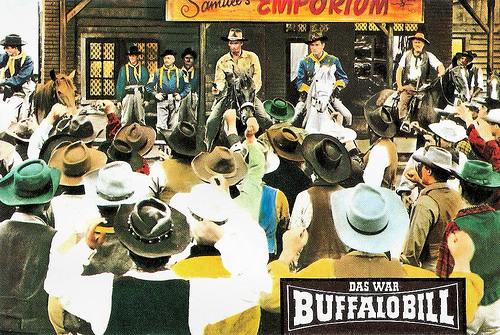
German collectors card by J & M Serienbilder Produktion Saar, no. 34. Photo: Gloria Film. Publicity still for Buffalo Bill, l'eroe del far west/Buffalo Bill, Hero of the Far West (Mario Costa, 1965) with Gordon Douglas. Caption: "Buffalo Bill hat sich auf die Fährte des weissen Waffenhändlers gesetzt, der die Rothäute zum Kampf aufwiegelt. Furchtlos hält Bill eine Übermacht rauher Burschen in Schach." (Buffalo Bill has set himself at the trail of the white arms dealer who incites the redskins to fight. Fearless Bill holds a a superior force of rough boys at bay.)
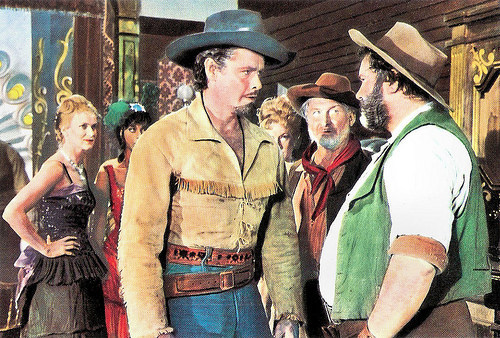
German collectors card by J & M Serienbilder Produktion Saar, no. 43. Photo: Gloria Film. Publicity still for Buffalo Bill, l'eroe del far west/Buffalo Bill, Hero of the Far West (Mario Costa, 1965) with Gordon Douglas. Caption: "Buffalo Bill begibt sich mit seinem Gefährten in die Höhle des Löwen. Als harmloser Gast horcht er in der Bar des Dunkelmannes Monroe herum, um zu erfahren wo die entführte Häuptlingstochter 'Mondstrahl' gefangen gehalten wird." (Buffalo Bill embarks with his companions in the lion's den. As harmless guest he listens around in the bar of the dark man Monroe to find out where 'Moonbeam', the chief's kidnapped daughter, is being held captive.)
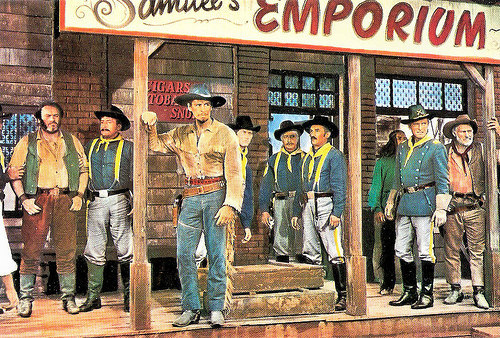
German collectors card by J & M Serienbilder Produktion Saar, no. 46. Photo: Gloria Film. Publicity still for Buffalo Bill, l'eroe del far west/Buffalo Bill, Hero of the Far West (Mario Costa, 1965). Caption: "Der erste Schurke, Big Sam, ist gefasst. Buffalo Bill hat bei ihm die Schiesseisen für die Rothäute gefunden. Big Sam gehört zu den Banditen, auf deren Konto die neunen Kämpfe zwischen Sioux und Weissen kommen." (The first villain, Big Sam is taken. Buffalo Bill has found at his place the firearms for the Redskins. Big Sam is one of the bandits, on whose account comes the new fighting between Sioux and whites.)
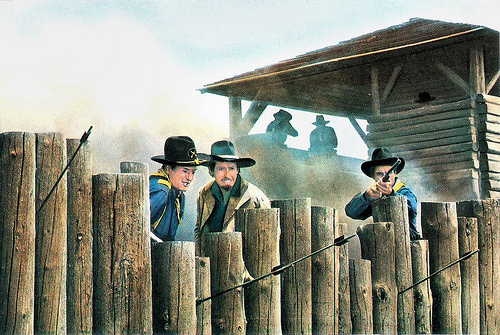
German collectors card by J & M Serienbilder Produktion Saar, no. 51. Photo: Gloria Film. Publicity still for Buffalo Bill, l'eroe del far west/Buffalo Bill, Hero of the Far West (Mario Costa, 1965) with Gordon Douglas. Caption: "'Gelbe Hand' vom Stamm der Sioux sieht seine hinterhältigen Manöver durchschaut. Er holt zum letzten Schlag gegen Fort Adam aus. Die von einem weissen Verräter gelieferten Feuerwaffen, den Buffalo Bill erledigt hat, sollen den Rothäuten den Sieg erkämpfen." ('Yellow Hand' of the tribe of Sioux sees his sneaky maneuver comprehended. He brings out the final blow to Fort Adam. The firearms, delivered by a white traitor, who Buffalo Bill has done in, have to help the Redskins to a victory.)
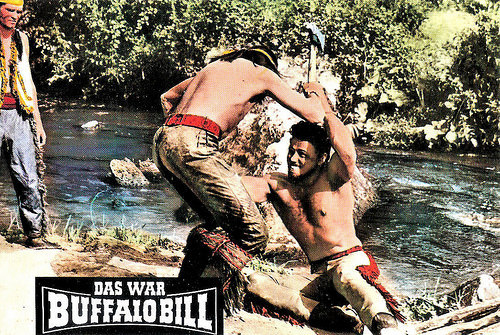
German collectors card by J & M Serienbilder Produktion Saar, no. 67. Photo: Gloria Film. Publicity still for Buffalo Bill, l'eroe del far west/Buffalo Bill, Hero of the Far West (Mario Costa, 1965) with Mirko Ellis and Gordon Scott (at right). Caption: "Wieder beweist der feige Häuptling Gelbe Hand'' im atemberaubenden Zweikampf mit Buffalo Bill seine Heimtücke. Er schmettert den Tomahawk auf den waffenlosen Gegner und deshalb verachten ihn jetzt sogar die eigenen Stammesgenossen." (Again the cowardly chief Yellow Hand hows his maliciousness in a breathtaking duel with Buffalo Bill. He smashes the Tomahawk on his unarmed opponent and therefore even his own tribesmen now despise him.)
Sources: Adam Bernstein (The Washington Post), Brian J. Walker (Brian’s Drive-In Theater), Bill Hillman (ERBzine), Mark Cerulli (Tarzan.cc), Wikipedia, and .

German collectors card by J & M Serienbilder Produktion Saar, no. 68. Photo: Gloria Film. Publicity still for Buffalo Bill, l'eroe del far west/Buffalo Bill, Hero of the Far West (Mario Costa, 1965). Caption: "In einem Zweikampf auf Leben und Tod hat Buffalo Bill, der berühmteste Held des Wilden Westens, seinen gefährlichsten Feind bezwungen. Der edle Kämpfer schenkt seinem Gegner das Leben. Die Indianer selbst sollen seine Strafe bestimmen." (In a duel to the death, Buffalo Bill, the famous hero of the Wild West, has defeated his most dangerous enemy. The noble warrior gives his opponent his life. The Indians themselves have to determine his punishment.)
Handsome features, muscular physique, and imposing height
Gordon Scott was born Gordon Merrill Werschkul in Portland, Oregon, in 1926. He was one of nine children of advertising man Stanley Werschkul and his wife Alice. He was raised in Oregon and studied Physical Education at the University of Oregon for one semester.
Upon leaving school, he joined the U.S. Army in 1944. He served as a drill sergeant and military policeman, and specialized in close order drill, judo and hand-to-hand combat. After his honourable discharge in 1947 he took on a variety of jobs, including fireman, cowboy, and farm-machinery salesman. In 1953 he was working as a lifeguard at the Sahara Hotel in Las Vegas when he was spotted by Hollywood agents, Ed and Walter Mayers. They were impressed by his handsome features, muscular physique, and imposing height.
Scott then beat out 200 contestants to replace Lex Barker as Edgar Rice Burroughs' famous jungle hero Tarzan. Film producer Sol Lesser offered him a 7 year contract, a loin cloth and a new last name. Reportedly, ‘Werschkul’ sounded too much like ‘Weissmuller’. So as Gordon Scott, he debuted in the low-budget Tarzan’s Hidden Jungle (Harold D. Schuster, 1955).
It led to a romance with co-star Vera Miles, who became his wife in 1956. They divorced in 1959. Tarzan’s Hidden Jungle was followed by Tarzan and the Lost Safari (H. Bruce Humberstone, 1957), the first Tarzan film in colour. It was filmed in Nairobi, British East Africa. In his early Tarzan films, Scott played the character as unworldly and inarticulate, in the mold of Johnny Weissmuller.
In 1958, Sol Lesser sold Scott's contract to Sy Weintraub. The new producer took his star to Paramount Pictures and, fueled by bigger production budgets, made two of the most successful Tarzan films, Tarzan's Greatest Adventure (John Guillermin, 1959) with Anthony Quayle and Sean Connery, and Tarzan the Magnificent (Robert Day, 1960) with Jock Mahoney. In these later films, Scott played a Tarzan who was educated and spoke perfect English, as in the original Edgar Rice Burroughs novels. Gordon Scott was the only actor to play Tarzan in both styles.

German postcard by Kunst und Bild, no. I 411. Photo: RKO. Publicity still for Tarzan's Hidden Jungle (Harold D. Schuster, 1955).

German postcard by Kolibri/Friedrich W. Sander-Verlag, Minden/Westf., no. 2322. Photo: Gloria Film. Publicity still for Maciste contro il vampiro/Maciste Vs. the Vampire (Giacomo Gentilomo, 1961).
Sword-and-sandal epics
Fearing he would become typecast as Tarzan, Gordon Scott moved to Italy. There he became a popular star of the Peplum genre, the sword-and-sandal epics featuring handsome bodybuilders as various characters from Greek and Roman myth.
Scott was an old training buddy of Hercules star Steve Reeves. Reeves had agreed to star in the Sergio Leone-penned saga Romolo e Remo/Duel of the Titans (Sergio Corbucci, 1961) about the two brothers of Roman Mythology, who founded Rome. The producer wanted Reeves to play both Romulus and Remus, but Reeves objected that the film would be more effective with another actor in the role of Remus. He recommended Gordon Scott, and the film co-starred Virna Lisi , Laura Solari, Massimo Girotti and Jacques Sernas . Scott was given the highest salary he had earned thus far for taking the role.
Next followed Maciste alla corte del Gran Khan/Maciste at the Court of the Great Khan (Riccardo Freda, 1961), which re-used the sets, extras and Yoko Tani as a princess from Marco Polo (Piero Pierotti, Hugo Fregonese, 1961) and Freda's I mongoli/The Mongols (André De Toth, Leopoldo Savona, Riccardo Freda, 1961).
Scott played Julius Caesar opposite Pascale Petit as Cleopatra in the historical drama Una regina per Cesare/A Queen for Caesar (Piero Pierotti, Victor Tourjansky, 1962) set in Egypt in 48 BC. Unlike other films about Caesar and Cleopatra, this film focuses entirely on the dynastic struggle within Egypt leading up to the arrival of Caesar, and in fact, we only see him in the closing scene of the film when he arrives at The Ptolemaic Palace in Alexandria. 20th Century Fox bought the rights for the film to keep it out of release lest it compete with their own Cleopatra, featuring Elizabeth Taylor. Scott also played Hercules in a couple of international co-productions during the mid-1960s.

Small Romanian collectors card. Photo: publicity still for Romolo e Remo/Duel of the Titans (Sergio Corbucci, 1961).

Vintage postcard.
Buffalo Bill
As the Peplum genre faded, Gordon Scott starred in other genre films. His first Spaghetti Western was Buffalo Bill, l'eroe del far west/Buffalo Bill, Hero of the Far West (Mario Costa, 1964) with Jan Hendriks .
He also starred in the Eurospy film Il Raggio infernale/Danger!! Death Ray (Gianfranco Baldanello, 1967), released at a time when the James Bond films, and spy films in general, were very popular internationally. His early military combat and martial arts training made it possible for him to do many of his own stunts.
His final film appearance was in the Spaghetti Western Gli uomini dal passo pesante/The Tramplers (Albert Band, Mario Sequi, 1966-1968) with Joseph Cotten and Franco Nero. He left Italy, and never made another film. He was trailed by a reputation as a ladies' man who seldom paid his bills, according to a 1987 article in the Toronto Star. For the last two decades of his life, Scott was a popular guest at film conventions and autograph shows and sold knives.
In 2007, Gordon Scott died, aged 80, in Baltimore, Maryland, of lingering complications from multiple heart surgeries earlier in the year. Adam Bernstein in his obituary in The Washington Post: “He lived with a series of obliging friends and ‘Tarzan’ fans, most recently in Baltimore. He had a troubled marriage to Miles, who apparently was under the impression that she was his first wife. She was his second or third, by varying accounts. He was seldom in contact with his surviving family, which includes a brother and two sisters. He had a son with Miles, and it's unclear how many other children he might have had. He was estranged from nearly everyone.”
Scott was married three times. His first marriage was with Janice Mae Wynkoop, of Oakland, California. They met when he was a lifeguard at Lake Temescal, located in Oakland, California. The couple married in Reno, Nevada, in 1948, and had one child, Karen Judith Werschkul (1948), before divorcing in 1949. His second marriage was to a woman he met while they were both working at the Sahara Hotel in Las Vegas. Gordon as a lifeguard and his wife as a PBX operator. They soon married and had a son, Eric, but the marriage ended once Gordon's acting career took off. With Vera Miles, he had one son, Michael (1957).

German collectors card by J & M Serienbilder Produktion Saar, no. 34. Photo: Gloria Film. Publicity still for Buffalo Bill, l'eroe del far west/Buffalo Bill, Hero of the Far West (Mario Costa, 1965) with Gordon Douglas. Caption: "Buffalo Bill hat sich auf die Fährte des weissen Waffenhändlers gesetzt, der die Rothäute zum Kampf aufwiegelt. Furchtlos hält Bill eine Übermacht rauher Burschen in Schach." (Buffalo Bill has set himself at the trail of the white arms dealer who incites the redskins to fight. Fearless Bill holds a a superior force of rough boys at bay.)

German collectors card by J & M Serienbilder Produktion Saar, no. 43. Photo: Gloria Film. Publicity still for Buffalo Bill, l'eroe del far west/Buffalo Bill, Hero of the Far West (Mario Costa, 1965) with Gordon Douglas. Caption: "Buffalo Bill begibt sich mit seinem Gefährten in die Höhle des Löwen. Als harmloser Gast horcht er in der Bar des Dunkelmannes Monroe herum, um zu erfahren wo die entführte Häuptlingstochter 'Mondstrahl' gefangen gehalten wird." (Buffalo Bill embarks with his companions in the lion's den. As harmless guest he listens around in the bar of the dark man Monroe to find out where 'Moonbeam', the chief's kidnapped daughter, is being held captive.)

German collectors card by J & M Serienbilder Produktion Saar, no. 46. Photo: Gloria Film. Publicity still for Buffalo Bill, l'eroe del far west/Buffalo Bill, Hero of the Far West (Mario Costa, 1965). Caption: "Der erste Schurke, Big Sam, ist gefasst. Buffalo Bill hat bei ihm die Schiesseisen für die Rothäute gefunden. Big Sam gehört zu den Banditen, auf deren Konto die neunen Kämpfe zwischen Sioux und Weissen kommen." (The first villain, Big Sam is taken. Buffalo Bill has found at his place the firearms for the Redskins. Big Sam is one of the bandits, on whose account comes the new fighting between Sioux and whites.)

German collectors card by J & M Serienbilder Produktion Saar, no. 51. Photo: Gloria Film. Publicity still for Buffalo Bill, l'eroe del far west/Buffalo Bill, Hero of the Far West (Mario Costa, 1965) with Gordon Douglas. Caption: "'Gelbe Hand' vom Stamm der Sioux sieht seine hinterhältigen Manöver durchschaut. Er holt zum letzten Schlag gegen Fort Adam aus. Die von einem weissen Verräter gelieferten Feuerwaffen, den Buffalo Bill erledigt hat, sollen den Rothäuten den Sieg erkämpfen." ('Yellow Hand' of the tribe of Sioux sees his sneaky maneuver comprehended. He brings out the final blow to Fort Adam. The firearms, delivered by a white traitor, who Buffalo Bill has done in, have to help the Redskins to a victory.)

German collectors card by J & M Serienbilder Produktion Saar, no. 67. Photo: Gloria Film. Publicity still for Buffalo Bill, l'eroe del far west/Buffalo Bill, Hero of the Far West (Mario Costa, 1965) with Mirko Ellis and Gordon Scott (at right). Caption: "Wieder beweist der feige Häuptling Gelbe Hand'' im atemberaubenden Zweikampf mit Buffalo Bill seine Heimtücke. Er schmettert den Tomahawk auf den waffenlosen Gegner und deshalb verachten ihn jetzt sogar die eigenen Stammesgenossen." (Again the cowardly chief Yellow Hand hows his maliciousness in a breathtaking duel with Buffalo Bill. He smashes the Tomahawk on his unarmed opponent and therefore even his own tribesmen now despise him.)
Sources: Adam Bernstein (The Washington Post), Brian J. Walker (Brian’s Drive-In Theater), Bill Hillman (ERBzine), Mark Cerulli (Tarzan.cc), Wikipedia, and .
Published on August 18, 2015 22:00
August 17, 2015
Léontine Massart
Léontine Massart (1885-1980) was a French stage and screen actress of Belgian origin. She peaked in French silent film of the early 1910s.
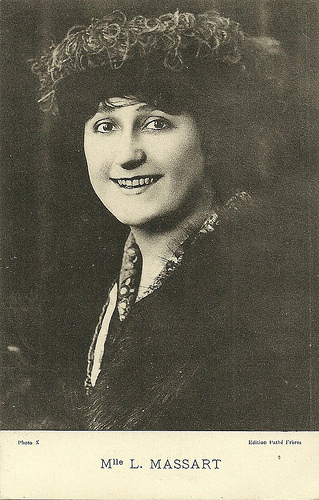
French postcard bt Edition Pathé Frères. Photo: X.
Muse or fetish
Léontine Massart was born in Brussels in 1885. She was the sister of Mary Massart, who would marry and become the muse of French film director René Plaisetty. Mary acted in his films between 1918 and 1922.
Stage director and actor Firmin Gémier discovered Léontine Massart in Brussels where she was acting with an amateur theatre company. She joined him in Paris where in 1909 she acted in his direction of Master Bob, gagnant du Derby by Henry de Brisay and Marcel Lauras.
From 1909 she also acted at the companies of the Théâtre de l'Ambigu and the Théâtre Antoine.
Parallel she ran a career as silent film actress, in particular in many films directed by Camille de Morlhon whose muse or fetish she was for several years. From 1912 Massart exclusively focused on film acting, though she did direct one play during the First World War: Bravo (1916).
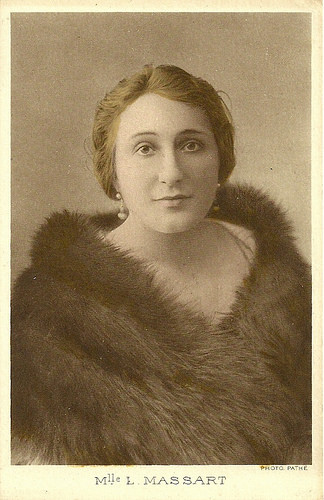
French postcard. Photo Pathé.
Joan of Arc
In 1908 Léontine Massart made her cinema debut in Albert Capellani’s Jeanne d’Arc/La vie de Jeanne d’Arc, right away playing the title role. After this production at Pathé Frères she became a regular Pathé actress, acting in countless shorts by the company of the Red Rooster.
Her repertory included historical and biblical dramas, such as Le tyran de Jérusalem (Camille de Morlhon, 1910) after Tasso, Le siège de Calais (Henri Andréani, 1911), Le jugement de Salomon (Henri Andréani, 1912), Le fils prodigue (Camille de Morlhon, 1912), Don Quichotte (Camille de Morlhon, 1913), La reine Margot (Henri Desfontaines, 1914) – in which she had the title role again, and Christophe Colomb (Gérard Bourgeois 1916) – in which she played Queen Isabella.
Massart also performed in modern dramas such as Par l’enfant (Camille de Morlhon, 1909), Le violon de grand-père (Michel Carré, 1911), L’envieuse (Albert Capellani, 1911), La fille des chiffoniers (Georges Monca, 1912), La broyeuse de coeurs (Camille de Morlhon, 1913) and Sacrifice surhumain (Camille de Morlhon, 1914).
She also figured in several comedies and farces such as some of the Rigadin comedies with the actor Prince such as Rigadin veut dormir tranquille (Georges Monca, 1910) and Le voile du bonheur (Albert Capellani, 1910), after a play by Georges Clemenceau, who is more famous as politician and whose only artistic work this was.
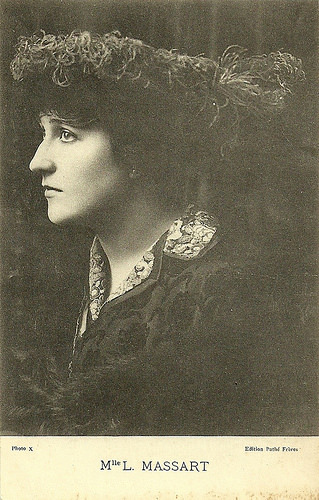
French postcard by Pathé Frères. Photo: X.
The end of a steady career
While Léontine Massart had a quite steady career in the 1910s up to the 1919 drama Le calvaire d’une reine by René Leprince and Ferdinand Zecca, she only performed in one film in the 1920s.
She only played in Mon p’tit (René Plaisetty, 1925) starring Ar lette Marchal. It was also her last film.
By then, she was 40. All in all Massart had acted in well over 40 films, both short and feature-length, and almost 20 of these were directed by Camille De Morlhon.
Important male partners of Massart in these years were Henry Krauss , Henri Etievant, Pierre Magnier, Jean Kemm, Paul Capellani , Jean Dax, Firmin Gémier, and in particular Paul Franck.
Léontine Massart died in Paris in 1980 at the high age of 95 years.
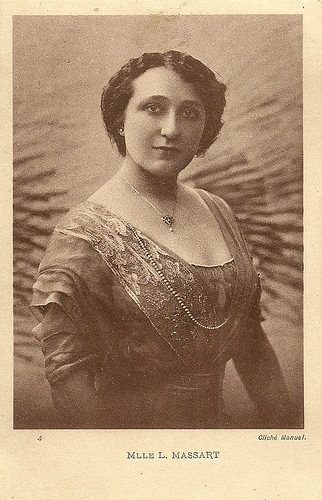
French postcard, no. 4. Photo: Manuel.
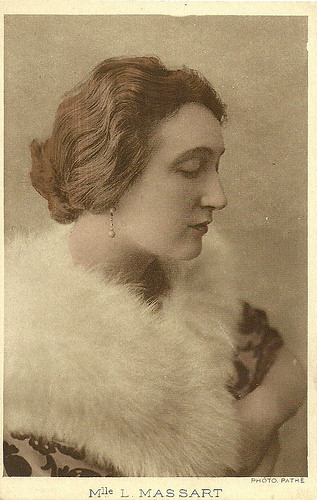
French postcard. Photo: Pathé.
Sources: Wikipedia (French) and .

French postcard bt Edition Pathé Frères. Photo: X.
Muse or fetish
Léontine Massart was born in Brussels in 1885. She was the sister of Mary Massart, who would marry and become the muse of French film director René Plaisetty. Mary acted in his films between 1918 and 1922.
Stage director and actor Firmin Gémier discovered Léontine Massart in Brussels where she was acting with an amateur theatre company. She joined him in Paris where in 1909 she acted in his direction of Master Bob, gagnant du Derby by Henry de Brisay and Marcel Lauras.
From 1909 she also acted at the companies of the Théâtre de l'Ambigu and the Théâtre Antoine.
Parallel she ran a career as silent film actress, in particular in many films directed by Camille de Morlhon whose muse or fetish she was for several years. From 1912 Massart exclusively focused on film acting, though she did direct one play during the First World War: Bravo (1916).

French postcard. Photo Pathé.
Joan of Arc
In 1908 Léontine Massart made her cinema debut in Albert Capellani’s Jeanne d’Arc/La vie de Jeanne d’Arc, right away playing the title role. After this production at Pathé Frères she became a regular Pathé actress, acting in countless shorts by the company of the Red Rooster.
Her repertory included historical and biblical dramas, such as Le tyran de Jérusalem (Camille de Morlhon, 1910) after Tasso, Le siège de Calais (Henri Andréani, 1911), Le jugement de Salomon (Henri Andréani, 1912), Le fils prodigue (Camille de Morlhon, 1912), Don Quichotte (Camille de Morlhon, 1913), La reine Margot (Henri Desfontaines, 1914) – in which she had the title role again, and Christophe Colomb (Gérard Bourgeois 1916) – in which she played Queen Isabella.
Massart also performed in modern dramas such as Par l’enfant (Camille de Morlhon, 1909), Le violon de grand-père (Michel Carré, 1911), L’envieuse (Albert Capellani, 1911), La fille des chiffoniers (Georges Monca, 1912), La broyeuse de coeurs (Camille de Morlhon, 1913) and Sacrifice surhumain (Camille de Morlhon, 1914).
She also figured in several comedies and farces such as some of the Rigadin comedies with the actor Prince such as Rigadin veut dormir tranquille (Georges Monca, 1910) and Le voile du bonheur (Albert Capellani, 1910), after a play by Georges Clemenceau, who is more famous as politician and whose only artistic work this was.

French postcard by Pathé Frères. Photo: X.
The end of a steady career
While Léontine Massart had a quite steady career in the 1910s up to the 1919 drama Le calvaire d’une reine by René Leprince and Ferdinand Zecca, she only performed in one film in the 1920s.
She only played in Mon p’tit (René Plaisetty, 1925) starring Ar lette Marchal. It was also her last film.
By then, she was 40. All in all Massart had acted in well over 40 films, both short and feature-length, and almost 20 of these were directed by Camille De Morlhon.
Important male partners of Massart in these years were Henry Krauss , Henri Etievant, Pierre Magnier, Jean Kemm, Paul Capellani , Jean Dax, Firmin Gémier, and in particular Paul Franck.
Léontine Massart died in Paris in 1980 at the high age of 95 years.

French postcard, no. 4. Photo: Manuel.

French postcard. Photo: Pathé.
Sources: Wikipedia (French) and .
Published on August 17, 2015 22:00
August 16, 2015
Lilian Harvey, Part 2
Today we present you the second part of our tribute to Ufa's biggest star of the 1930s: British born actress and singer Lilian Harvey (1906-1968). With Willy Fritsch she formed the 'Dream Team of the European Cinema'. The international success of Der Kongress Tanzt/The Congress Dances led Harvey to Hollywood.
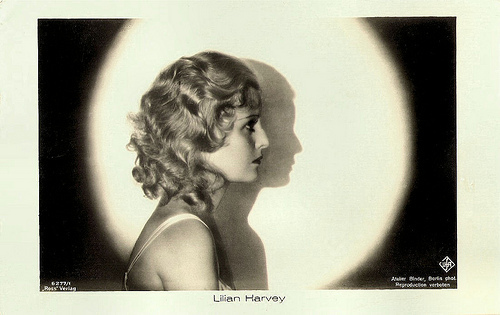
German postcard by Ross Verlag, no. 6277/1, 1931-1932. Photo: Atelier Binder, Berlin / Ufa.
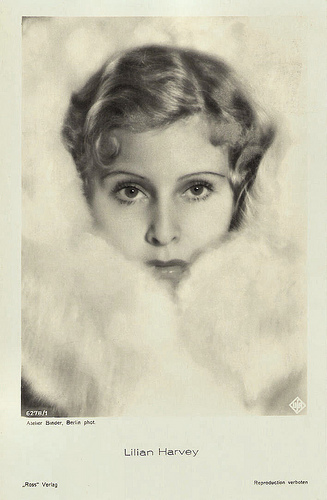
German postcard by Ross Verlag, no. 6278/1, 1931-1932. Photo: Atelier Binder / Ufa.
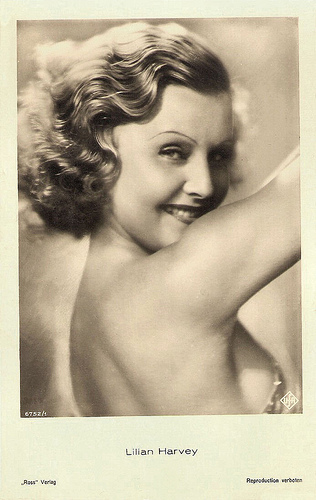
German postcard by Ross Verlag, no. 6752/1, 1931-1932. Photo: Ufa.
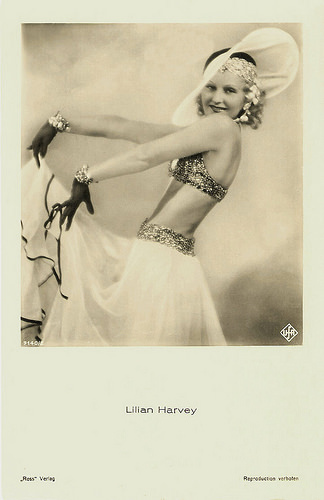
German postcard by Ross Verlag, no. 7140/2, 1932-1933. Photo: Ufa.
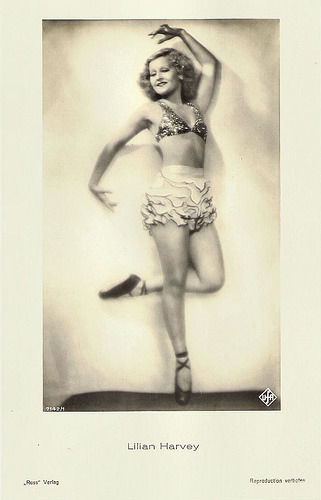
German postcard by Ross Verlag, no. 7142/1, 1932-1933. Photo: Ufa. Collection: Egbert Barten.
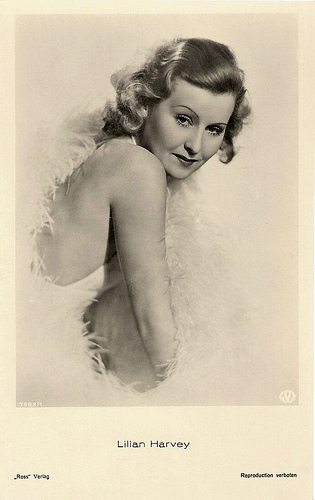
German postcard by Ross Verlag, no. 7682/1, 1932-1933. Photo: Fox.
Hollywood
Before going to Hollywood, Lilian Harvey first appeared in the British romance The Only Girl (Friedrich Hollaender, 1934) with Charles Boyer .
Her Hollywood debut for 20th Century Fox was the film operetta My Lips Betray (John G. Blystone, 1933) with John Boles. Of this film now only rests an incomplete print. It was held back in favour of Harvey's second outing, My Weakness (David Butler, 1933) with Lew Ayres, which, despite its title, was considered a stronger effort.
At AllMovie , Hal Erickson writes: "Clearly inspired by the Lubitsch and Clair musical semi-fantasies then in vogue, My Weakness is replete with rhyming dialogue, talking animals, and even a singing statue of Auguste Rodin's The Thinker. The Buddy G. DeSylva-Leo Robin-Richard Whiting score is largely unmemorable save for Gather Lip Rouge While You May, which deserves a gold star for the title alone."
Her last musical for Fox was I Am Suzanne (Rowland V. Lee, 1933). Hal Erickson writes about this film: "International musical-comedy favorite Lillian Harvey is as delightful as ever in the bizarre romantic tunefest I Am Suzanne. In a plotline curiously similar to the much-later Lili, Harvey is cast as Suzanne, a crippled dancer in love with young, self-involved puppeteer Tony (Gene Raymond), who finds it easier to talk to his wooden-headed creations than to human beings. (...) Rowland V. Lee's direction of I Am Suzanne is almost as Germanically symbolic as his later handling of Universal's Tower of London and Son of Frankenstein."
Then she appeared for Columbia Pictures in the romantic comedy Let's Live Tonight (Victor Schertzinger, 1935), co-starring Tullio Carminati .
In 1935 she returned to Europe. In Great Britain she starred in the musical Invitation to the Waltz (Paul Merzbach, 1935), and then she returned to Germany to be with her lover, director Paul Martin.
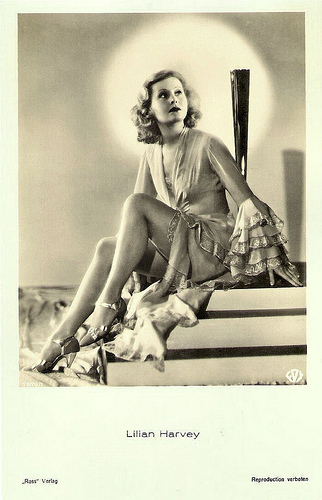
German postcard by Ross Verlag, no. 7679/1, 1932-1933. Photo: Fox. Publicity still for My Lips Betray (John G. Blystone, 1933).
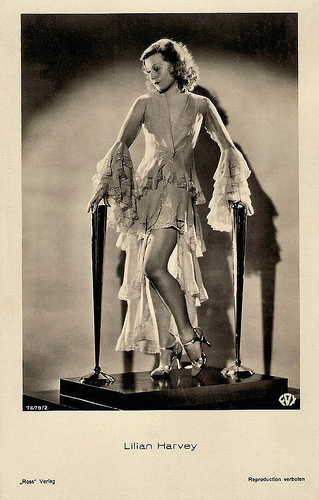
German postcard by Ross Verlag, no. 7679/2, 1932-1933. Photo: Fox. Publicity still for My Lips Betray (John G. Blystone, 1933).
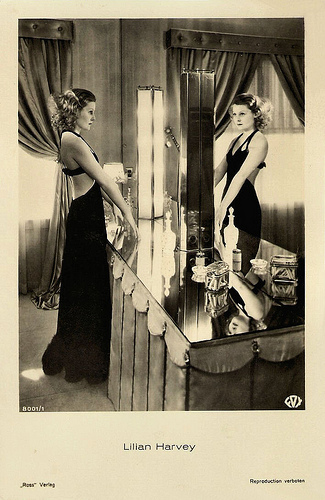
German postcard by Ross Verlag, no. 8001/1, 1933-1934. Photo: Fox.
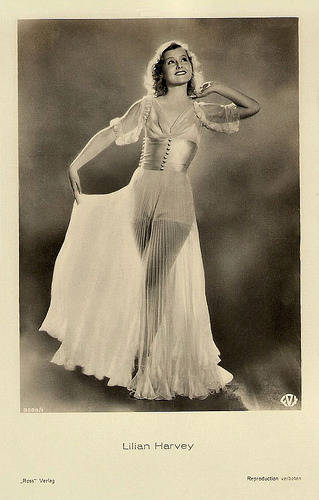
German postcard by Ross Verlag, no. 8000/1, 1933-1934. Photo: Fox.
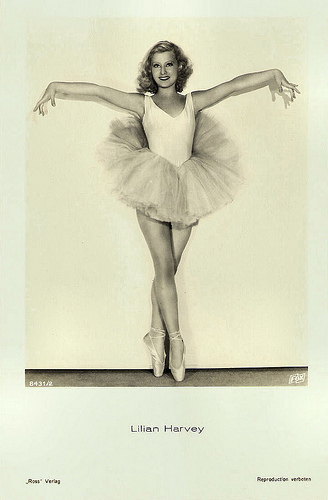
German postcard by Ross Verlag, no. 8431/2, 1933-1934. Photo: Fox. Publicity still for I am Suzanne! (Rowland V. Lee, 1933).
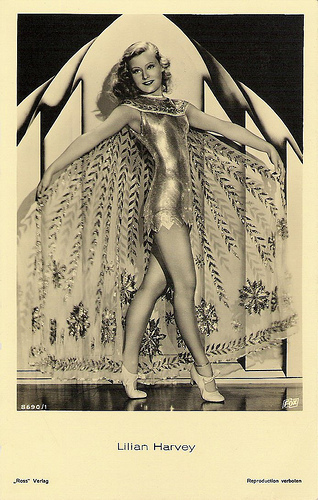
German postcard by Ross Verlag, no. 8690/1,1933-1934. Photo: Fox.
Gestapo
Lilian Harvey returned to the Ufa studios in Schwarze Rosen/Black Roses (Paul Martin, 1935). It was again filmed in three languages: German, French and English.
But not everything was the same as before her years in Hollywood. In her absence, the Nazi regime had come to power in Germany and the Gestapo found out that she still made invitations to her Jewish colleagues.
She came under observation, but she nevertheless made successful Ufa-films such as the screwball comedy Glückskinder/Lucky Kids (Paul Martin, 1936) with Willy Fritsch , the historical musical Fanny Eisler (Paul Martin, 1937) with Willy Birgel , and the comedy Frau am Steuer/Woman at the Wheel (Paul Martin, 1939) again with Willy Fritsch .
When Harvey helped the choreographer Jens Keith to escape to Switzerland this led to an interrogation by the Gestapo. A great part of her fortune that was invested in real estate was confiscated by the Nazis, and Harvey left Germany.
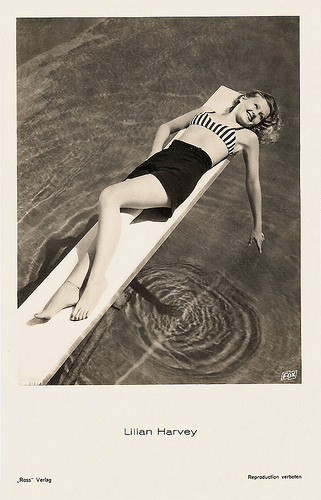
German postcard by Ross Verlag, no. 8581/1, 1933-1934. Photo: Fox (20th Century Fox).
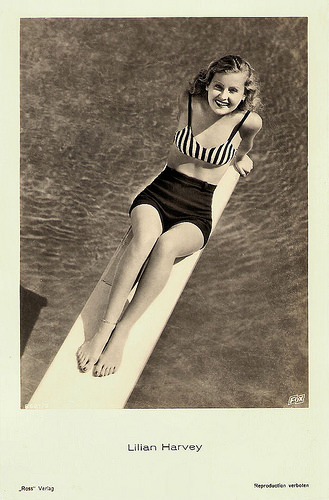
German postcard by Ross Verlag, no. 8581/3, 1933-1934. Photo: Fox (20th Century Fox).
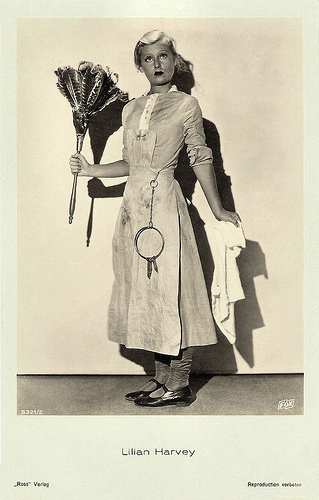
German postcard by Ross Verlag, no. 8321/2,1933-1934. Photo: Fox.
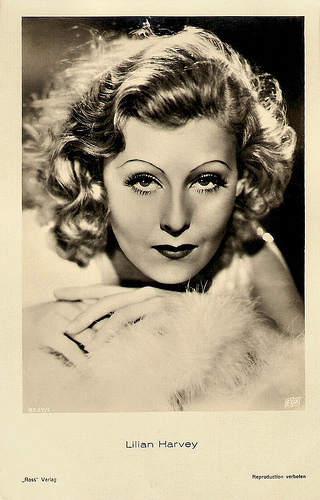
German postcard by Ross Verlag, no. 8227/1, 1933-1934. Photo: Fox.
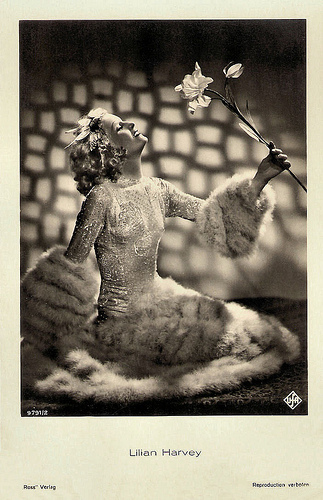
German postcard by Ross Verlag, no. 9791/2,1934-1935. Photo: Ufa.
Volunteer Nurse
In France, Lilian Harvey made her last two films, Sérénade/Schubert's Serenade (Jean Boyer, 1940) with Bernard Lancret as composer Franz Schubert, and Miquette (Jean Boyer, 1940) with Lucien Baroux.
After the occupation of southern France she emigrated again, now to Los Angeles to work as a volunteer nurse. Since she had done performances for French troop care the Nazi regime withdraw her German citizenship in 1943.
Her former directors and co-workers like Michael Curtiz and Billy Wilder remained social contacts, but her stigma of having been Ufa's biggest star kept her from reigniting her film career.
After the war, Harvey returned to Paris. In the following years, she travelled as a singer through Scandinavia and Egypt. In 1949, she returned to Germany and performed on stage.
From 1953 to 1957, she was married to Danish theatre agent Hartvig Valeur-Larsen. She received war reparations in the early 1960s, and she lived on the Riviera. Eventually her secretary Else-Pitty Wirth became her partner.
Lilian Harvey died of liver failure in 1968 in Juan-les-Pins, France.
In 2009 Quentin Tarantino revived one of Lilian Harvey's greatest songs in his film Inglourious Basterds (2009). The hilarious Ich wollt' ich wär ein Huhn (I would like to be a chicken) written by Hans Fritz Beckmann and Peter Kreuder, can be heard on the soundtrack of the film. Harvey sang it with Willy Fritsch in Glückskinder/Lucky Kids (Paul Martin, 1936).
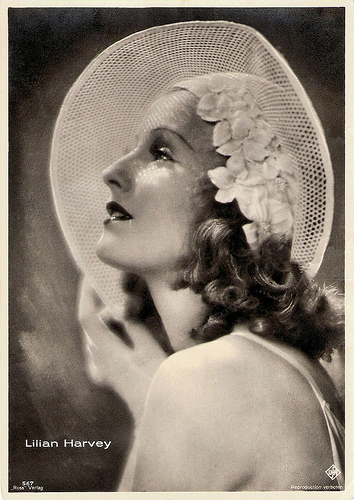
German postcard by Ross Verlag, no. 567. Photo: Ufa.
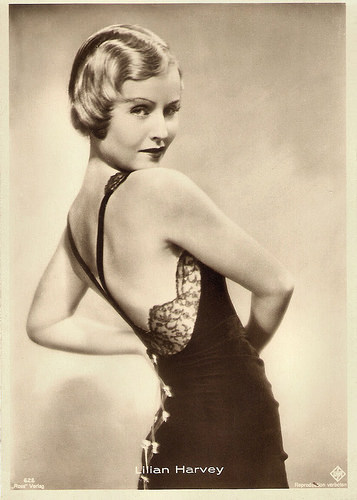
German postcard by Ross Verlag, no. 628. Photo: Ufa. Collection: Egbert Barten.
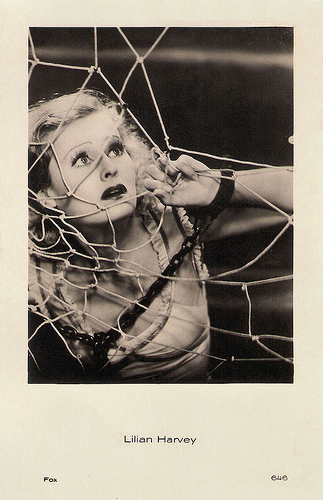
Dutch postcard, no. 646. Photo: Fox.
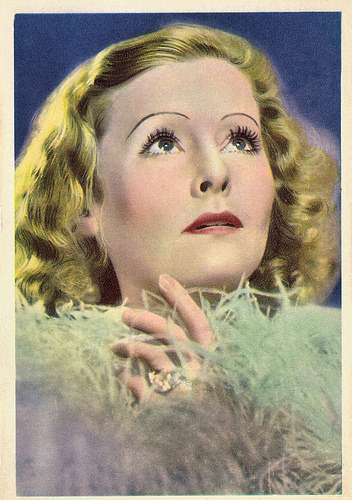
British collectors card by Godfrey Phillips and Associated Companies' Cigarettes, no. 20. Photo: British International Pictures (B.I.P.) Publicity still for Invitation to the Waltz (Paul Merzbach, 1935).
Lilian Harvey sings Guten Tag, Liebes Glück (1939) with images of Schwarze Rosen (Paul Martin, 1935). Source: Raiwons (YouTube).
Clip of Ich wollt' ich wär' ein Huhn from Glückskinder/Lucky Kids (Paul Martin, 1936). Source: Sittichfan (YouTube).
Lilian Harvey sings Si j'étais un homme (If I were A Man) in Miquette (Jean Boyer, 1940).
Sources: Thomas Staedeli (Cyranos), Sandra Brennan (AllMovie), Hal Erickson (AllMovie), (IMDb), Wikipedia, and .

German postcard by Ross Verlag, no. 6277/1, 1931-1932. Photo: Atelier Binder, Berlin / Ufa.

German postcard by Ross Verlag, no. 6278/1, 1931-1932. Photo: Atelier Binder / Ufa.

German postcard by Ross Verlag, no. 6752/1, 1931-1932. Photo: Ufa.

German postcard by Ross Verlag, no. 7140/2, 1932-1933. Photo: Ufa.

German postcard by Ross Verlag, no. 7142/1, 1932-1933. Photo: Ufa. Collection: Egbert Barten.

German postcard by Ross Verlag, no. 7682/1, 1932-1933. Photo: Fox.
Hollywood
Before going to Hollywood, Lilian Harvey first appeared in the British romance The Only Girl (Friedrich Hollaender, 1934) with Charles Boyer .
Her Hollywood debut for 20th Century Fox was the film operetta My Lips Betray (John G. Blystone, 1933) with John Boles. Of this film now only rests an incomplete print. It was held back in favour of Harvey's second outing, My Weakness (David Butler, 1933) with Lew Ayres, which, despite its title, was considered a stronger effort.
At AllMovie , Hal Erickson writes: "Clearly inspired by the Lubitsch and Clair musical semi-fantasies then in vogue, My Weakness is replete with rhyming dialogue, talking animals, and even a singing statue of Auguste Rodin's The Thinker. The Buddy G. DeSylva-Leo Robin-Richard Whiting score is largely unmemorable save for Gather Lip Rouge While You May, which deserves a gold star for the title alone."
Her last musical for Fox was I Am Suzanne (Rowland V. Lee, 1933). Hal Erickson writes about this film: "International musical-comedy favorite Lillian Harvey is as delightful as ever in the bizarre romantic tunefest I Am Suzanne. In a plotline curiously similar to the much-later Lili, Harvey is cast as Suzanne, a crippled dancer in love with young, self-involved puppeteer Tony (Gene Raymond), who finds it easier to talk to his wooden-headed creations than to human beings. (...) Rowland V. Lee's direction of I Am Suzanne is almost as Germanically symbolic as his later handling of Universal's Tower of London and Son of Frankenstein."
Then she appeared for Columbia Pictures in the romantic comedy Let's Live Tonight (Victor Schertzinger, 1935), co-starring Tullio Carminati .
In 1935 she returned to Europe. In Great Britain she starred in the musical Invitation to the Waltz (Paul Merzbach, 1935), and then she returned to Germany to be with her lover, director Paul Martin.

German postcard by Ross Verlag, no. 7679/1, 1932-1933. Photo: Fox. Publicity still for My Lips Betray (John G. Blystone, 1933).

German postcard by Ross Verlag, no. 7679/2, 1932-1933. Photo: Fox. Publicity still for My Lips Betray (John G. Blystone, 1933).

German postcard by Ross Verlag, no. 8001/1, 1933-1934. Photo: Fox.

German postcard by Ross Verlag, no. 8000/1, 1933-1934. Photo: Fox.

German postcard by Ross Verlag, no. 8431/2, 1933-1934. Photo: Fox. Publicity still for I am Suzanne! (Rowland V. Lee, 1933).

German postcard by Ross Verlag, no. 8690/1,1933-1934. Photo: Fox.
Gestapo
Lilian Harvey returned to the Ufa studios in Schwarze Rosen/Black Roses (Paul Martin, 1935). It was again filmed in three languages: German, French and English.
But not everything was the same as before her years in Hollywood. In her absence, the Nazi regime had come to power in Germany and the Gestapo found out that she still made invitations to her Jewish colleagues.
She came under observation, but she nevertheless made successful Ufa-films such as the screwball comedy Glückskinder/Lucky Kids (Paul Martin, 1936) with Willy Fritsch , the historical musical Fanny Eisler (Paul Martin, 1937) with Willy Birgel , and the comedy Frau am Steuer/Woman at the Wheel (Paul Martin, 1939) again with Willy Fritsch .
When Harvey helped the choreographer Jens Keith to escape to Switzerland this led to an interrogation by the Gestapo. A great part of her fortune that was invested in real estate was confiscated by the Nazis, and Harvey left Germany.

German postcard by Ross Verlag, no. 8581/1, 1933-1934. Photo: Fox (20th Century Fox).

German postcard by Ross Verlag, no. 8581/3, 1933-1934. Photo: Fox (20th Century Fox).

German postcard by Ross Verlag, no. 8321/2,1933-1934. Photo: Fox.

German postcard by Ross Verlag, no. 8227/1, 1933-1934. Photo: Fox.

German postcard by Ross Verlag, no. 9791/2,1934-1935. Photo: Ufa.
Volunteer Nurse
In France, Lilian Harvey made her last two films, Sérénade/Schubert's Serenade (Jean Boyer, 1940) with Bernard Lancret as composer Franz Schubert, and Miquette (Jean Boyer, 1940) with Lucien Baroux.
After the occupation of southern France she emigrated again, now to Los Angeles to work as a volunteer nurse. Since she had done performances for French troop care the Nazi regime withdraw her German citizenship in 1943.
Her former directors and co-workers like Michael Curtiz and Billy Wilder remained social contacts, but her stigma of having been Ufa's biggest star kept her from reigniting her film career.
After the war, Harvey returned to Paris. In the following years, she travelled as a singer through Scandinavia and Egypt. In 1949, she returned to Germany and performed on stage.
From 1953 to 1957, she was married to Danish theatre agent Hartvig Valeur-Larsen. She received war reparations in the early 1960s, and she lived on the Riviera. Eventually her secretary Else-Pitty Wirth became her partner.
Lilian Harvey died of liver failure in 1968 in Juan-les-Pins, France.
In 2009 Quentin Tarantino revived one of Lilian Harvey's greatest songs in his film Inglourious Basterds (2009). The hilarious Ich wollt' ich wär ein Huhn (I would like to be a chicken) written by Hans Fritz Beckmann and Peter Kreuder, can be heard on the soundtrack of the film. Harvey sang it with Willy Fritsch in Glückskinder/Lucky Kids (Paul Martin, 1936).

German postcard by Ross Verlag, no. 567. Photo: Ufa.

German postcard by Ross Verlag, no. 628. Photo: Ufa. Collection: Egbert Barten.

Dutch postcard, no. 646. Photo: Fox.

British collectors card by Godfrey Phillips and Associated Companies' Cigarettes, no. 20. Photo: British International Pictures (B.I.P.) Publicity still for Invitation to the Waltz (Paul Merzbach, 1935).
Lilian Harvey sings Guten Tag, Liebes Glück (1939) with images of Schwarze Rosen (Paul Martin, 1935). Source: Raiwons (YouTube).
Clip of Ich wollt' ich wär' ein Huhn from Glückskinder/Lucky Kids (Paul Martin, 1936). Source: Sittichfan (YouTube).
Lilian Harvey sings Si j'étais un homme (If I were A Man) in Miquette (Jean Boyer, 1940).
Sources: Thomas Staedeli (Cyranos), Sandra Brennan (AllMovie), Hal Erickson (AllMovie), (IMDb), Wikipedia, and .
Published on August 16, 2015 22:00
August 15, 2015
Lilian Harvey, Part 1
Ufa's biggest star of the 1930s was British born German actress and singer Lilian Harvey (1906-1968). With Willy Fritsch she formed the 'Dream Team of the European Cinema'. Today a post about Harvey's rise to fame in the silent cinema and about her greatest success with the early sound operetta Der Kongress Tanzt/The Congress Dances (1931). Tomorrow follows Part 2 about her later triumphs and failures during the Third Reich.
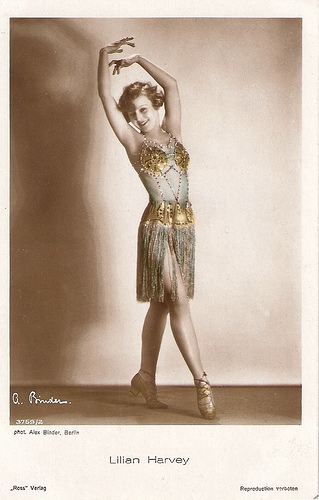
German postcard by Ross Verlag, no. 3759/2, 1928-1929. Photo: Alex Binder, Berlin. Ross Verlag.
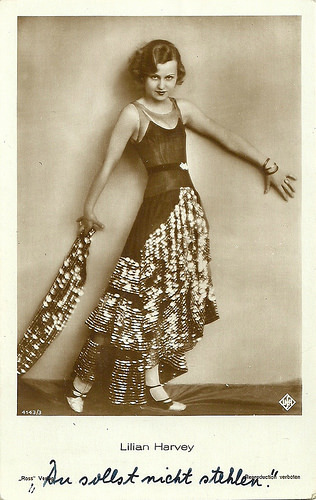
German postcard. Ross Verlag, no. 4143/3, 1929-1930. Photo: Ufa. Publicity still for the silent film Du sollst nicht stehlen/Thou Shalt Not Steal (Victor Janson, 1928).

German postcard by Ross Verlag, no. 4538/1, 1929-1930. Photo: Ufa.
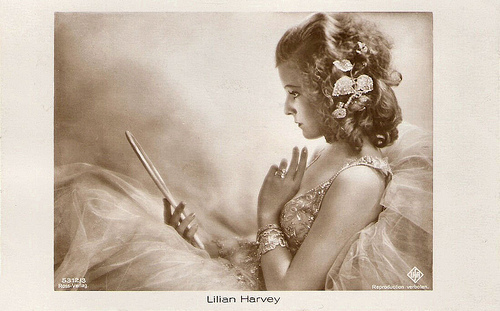
German postcard by Ross Verlag, no. 5312/3, 1930-1931. Photo: Ufa.
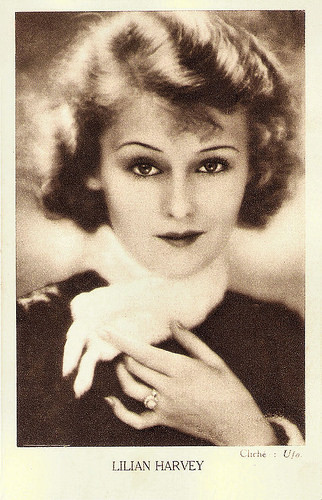
Dutch postcard by N.V. De Faam, Breda. Photo: Ufa.
Dream Team
Lilian Harvey was born Helene Lilian Muriel Pape in Hornsey (North London), Great Britain, in 1906. Her mother was English and her father was a German businessman, and when Lilian was eight they moved to Berlin.
At the beginning of World War I the family found itself in Magdeburg, and they were unwilling and unable to return to England. She spent much of WW I with an aunt in Solothurn in Switzerland. After the war she returned to Germany. She studied ballet at the Staatsoper Berlin in 1923 and worked in theatre revues. She assumed her grandmother's maiden name (Harvey) as her professional surname.
In 1924, Harvey received her first screen role as the young Jewish girl Ruth in the silent film Der Fluch/The Curse (Robert Land, 1925). Director-producer Richard Eichberg signed her on, and under his direction she played her first leading roles in Leidenschaft/Passion (Richard Eichberg, 1925) with Otto Gebühr , and Liebe und Trompetenblasen/Love and Trumpet Blows (Richard Eichberg, 1925) opposite Harry Liedtke .
A year later she acted for the first time with Willy Fritsch , in Die keusche Susanne/The Innocent Susanne (Richard Eichberg, 1926) - an anticipation of the future 'Dream Team of the European Cinema'.
Harvey appeared in the following years in such silent films as Die tolle Lola/Fabulous Lola (Richard Eichberg, 1927), Eine Nacht in London/A Night in London (Lupu Pick, 1928), and Adieu, Mascotte (Wilhelm Thiele, 1929) with Harry Halm .
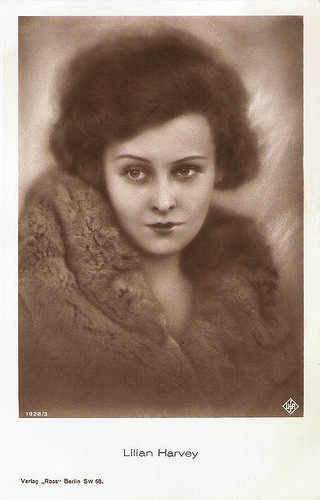
German postcard by Ross Verlag, no. 1928/3, 1927-1928. Photo: Ufa.
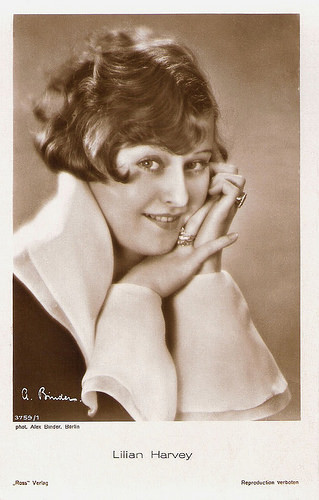
German postcard by Ross Verlag, no. 3759/1, 1928-1929. Photo: Alex Binder, Berlin.
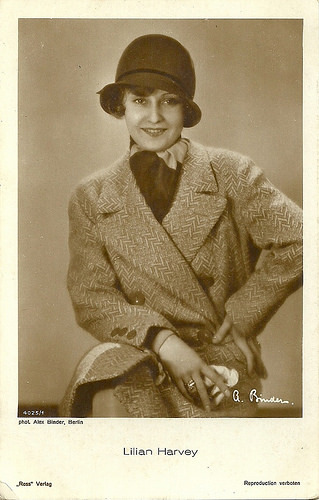
German postcard by Ross Verlag, no. 4025/1, 1929-1930. Photo: Alex Binder, Berlin.
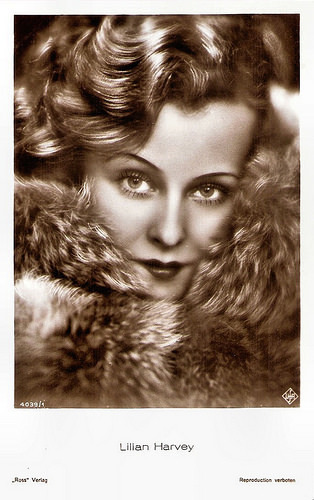
German postcard by Ross Verlag, no. 4039/1, 1929-1930. Photo: Ufa.
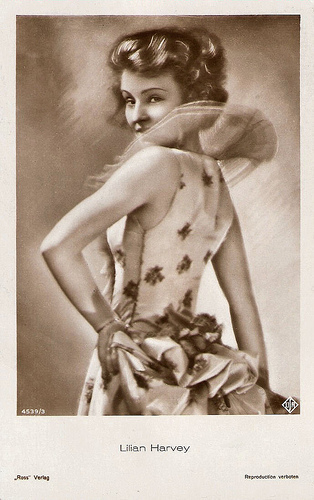
German postcard by Ross Verlag, no. 4539/3, 1929-1930. Photo: Ufa.
The Sweetest Girl
After many roles in silent films, Lilian Harvey was able to pursue a successful acting career during the initial sound film era of the early 1930s.
Because of her training as a singer and a dancer Ufa found great use for her in light operettas .
In the hit Liebeswalzer/The Love Waltz (Wilhelm Thiele, 1930) she starred with 'sunny boy' Willy Fritsch , and they became the 'dream couple' of the German cinema. Fritsch sang in the film the song Du bist das süßeste Mädel der Welt, a nd the press now dubbed Harvey the 'Sweetest Girl of the World'.
Together Harvey and Fritsch would make eleven box office hits, including Hokuspokus/Hocuspocus (Gustav Ucicky, 1930), Die Drei von der Tankstelle/Three Good Friends (Wilhelm Thiele, 1930), and Ein blonder Traum/A Blonde Dream (Paul Martin, 1932).
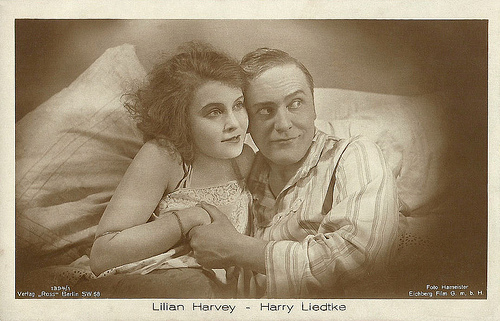
German postcard by Ross Verlag, no. 1394/1, 1927-1928. Photo: Hameister - Eichberg Film G.m.b.H. Publicity still for Liebe und Trompetenblasen/Love and Trumpet Blows (Richard Eichberg, 1925) with Harry Liedtke. Collection: Didier Hanson.
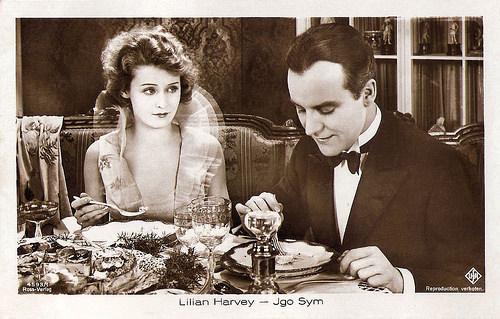
German postcard by Ross Verlag, no. 4593/1, 1929-1930. Photo: Ufa. Publicity still for Adieu Mascotte (Wilhelm Thiele, 1929) with Igo Sym.
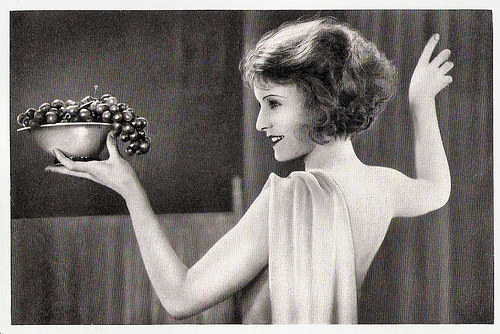
German collectors card in the series Sammelwert 'Der Stumme Film' by Ross Verlag, no. 10. Photo: Ufa. Publicity still for Adieu Mascotte (Wilhelm Thiele, 1929).
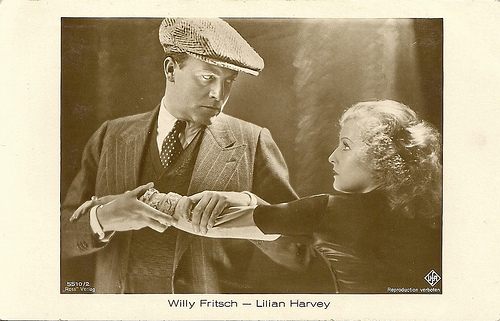
German postcard by Ross Verlag, no. 5510/2, 1930-1931. Photo: Ufa. Could be a publicity still for the early sound film Einbrecher/Burglar (Hanns Schwarz, 1930), in which Willy Fritsch is a burglar who gets an affair with a rich and neglected industrial's wife (Harvey).
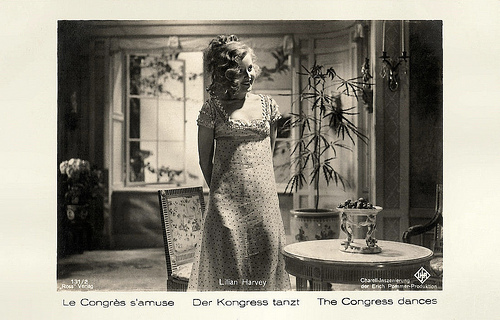
German postcard by Ross Verlag, no. 131/2. Photo: Ufa. Publicity still for Der Kongress tanzt/The Congress dances (Erik Charell, 1931).
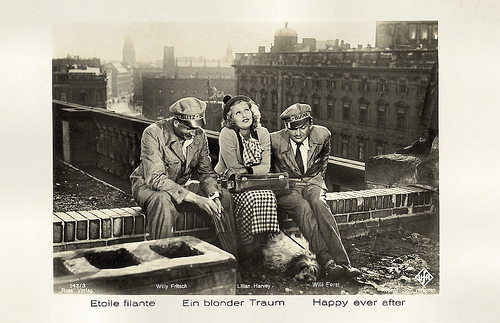
German postcard by Ross Verlag, no. 143/3, 1931-1932. Photo: Ufa. Publicity still for Ein blonder Traum/Happy Ever After (Paul Martin, 1932).
Capricious and extravagant operetta
The postcards above show Lilian Harvey as Vienna glove-sales-lady Christl in Der Kongress Tanzt/The Congress Dances (1931), the first and only German film of director Erik Charell. Charell used the Vienna congress as a background to the real story of Christl, who is causing an uproar because of her unconventional methods of advertising. She throws flower bouquets advertising her shop The Beautiful Shepherdess to all visiting dignitaries as they ride by in their coaches.
This immensely successful film operetta is not only a classic of the early German sound film, showing all the capabilities of the Ufa, but it was also a promising start of a film career that was not to be realized: Charell had to leave Nazi-Germany and was unable to continue his career as a film director abroad.
Der Kongress Tanzt is not a filmed operetta, but a real film operetta. The cast is great: next to Lilian Harvey and Willy Fritsch as Tsar Alexander of Russia, Conrad Veidt as the Machiavellan Prince Metternich, Lil Dagover as a glamorous countess, Paul Hörbiger and Otto Walburg are at their best.
Der Kongress tanzt has elegance, wit, beautiful sets, and brilliant music. Lilian Harvey's song Das gibt's nur einmal became an evergreen. In this musical sequence the heroine rides in a carriage to the castle she has been given by the Tsar. The scene is filmed in long takes where the camera just tracks and tracks and tracks, through the village, through the market place, through the fields and then goes on as she walks into the house. A 10 minutes masterpiece in its own right.
More than just direct, Erik Charell choreographed the film. Although the film stands on its own feet, the influence of Ernst Lubitsch is evident. Der Kongress tanzt got also English and French versions (as would be the case with her subsequent films). In those versions starred Lilian Harvey, but the crew and the rest of the cast were respectively British and French.
These foreign versions were so popular that Lilian Harvey became famous outside of Germany too. At IMDb , Jan Onderwater writes: "Der Kongress tanzt may not be perfect technically, but this is a sensual, made with great fun, original, capricious and extravagant operetta. Some scenes are even a bit bizarre and fetishistic. (...) It is curious that the film was not banned by Minister for Public Enlightenment and Propaganda Joseph Goebbels until October 1937."
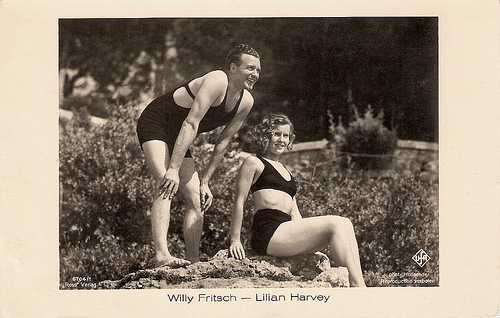
German postcard by Ross Verlag, no. 6704/1, 1931-1932. Photo: Hollaender / Ufa.
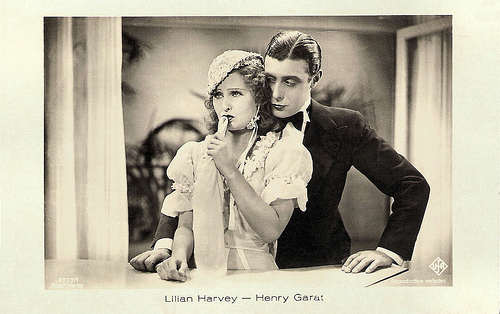
German postcard by Ross Verlag, no. 6739/1, 1931-1932. Photo: Ufa. Publicity still for Le Chemin du Paradis/The Road to Paradise (Wilhelm Thiele, Max de Vaucorbeil, 1930).
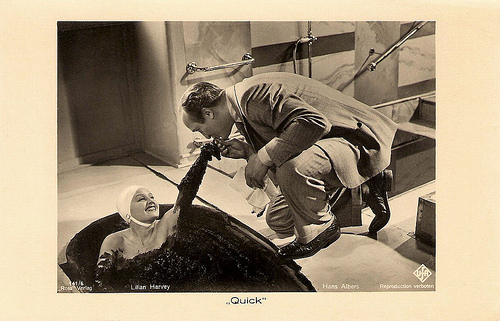
German postcard by Ross Verlag, no. 141/6. Photo: Ufa. Publicity still for Quick (Robert Siodmak, 1932) with Hans Albers. Collection: Egbert Barten.
Willy Fritsch & Lilian Harvey in Die keusche Susanne (1926). Source: Sittichfan (YouTube).
Final scene from Die Drei von der Tankstelle (1930). Source: Einliedgehtumdiewelt (YouTube).
Lilian Harvey sings Das gibt's nur einmal (Just Once For All Time) in Der Kongress Tanzt (1931). Source: Zaychatina (YouTube).
To be continued tomorrow.
Sources: Thomas Staedeli (Cyranos), Sandra Brennan (AllMovie), Jan Onderwater (IMDb), Wikipedia, and .

German postcard by Ross Verlag, no. 3759/2, 1928-1929. Photo: Alex Binder, Berlin. Ross Verlag.

German postcard. Ross Verlag, no. 4143/3, 1929-1930. Photo: Ufa. Publicity still for the silent film Du sollst nicht stehlen/Thou Shalt Not Steal (Victor Janson, 1928).

German postcard by Ross Verlag, no. 4538/1, 1929-1930. Photo: Ufa.

German postcard by Ross Verlag, no. 5312/3, 1930-1931. Photo: Ufa.

Dutch postcard by N.V. De Faam, Breda. Photo: Ufa.
Dream Team
Lilian Harvey was born Helene Lilian Muriel Pape in Hornsey (North London), Great Britain, in 1906. Her mother was English and her father was a German businessman, and when Lilian was eight they moved to Berlin.
At the beginning of World War I the family found itself in Magdeburg, and they were unwilling and unable to return to England. She spent much of WW I with an aunt in Solothurn in Switzerland. After the war she returned to Germany. She studied ballet at the Staatsoper Berlin in 1923 and worked in theatre revues. She assumed her grandmother's maiden name (Harvey) as her professional surname.
In 1924, Harvey received her first screen role as the young Jewish girl Ruth in the silent film Der Fluch/The Curse (Robert Land, 1925). Director-producer Richard Eichberg signed her on, and under his direction she played her first leading roles in Leidenschaft/Passion (Richard Eichberg, 1925) with Otto Gebühr , and Liebe und Trompetenblasen/Love and Trumpet Blows (Richard Eichberg, 1925) opposite Harry Liedtke .
A year later she acted for the first time with Willy Fritsch , in Die keusche Susanne/The Innocent Susanne (Richard Eichberg, 1926) - an anticipation of the future 'Dream Team of the European Cinema'.
Harvey appeared in the following years in such silent films as Die tolle Lola/Fabulous Lola (Richard Eichberg, 1927), Eine Nacht in London/A Night in London (Lupu Pick, 1928), and Adieu, Mascotte (Wilhelm Thiele, 1929) with Harry Halm .

German postcard by Ross Verlag, no. 1928/3, 1927-1928. Photo: Ufa.

German postcard by Ross Verlag, no. 3759/1, 1928-1929. Photo: Alex Binder, Berlin.

German postcard by Ross Verlag, no. 4025/1, 1929-1930. Photo: Alex Binder, Berlin.

German postcard by Ross Verlag, no. 4039/1, 1929-1930. Photo: Ufa.

German postcard by Ross Verlag, no. 4539/3, 1929-1930. Photo: Ufa.
The Sweetest Girl
After many roles in silent films, Lilian Harvey was able to pursue a successful acting career during the initial sound film era of the early 1930s.
Because of her training as a singer and a dancer Ufa found great use for her in light operettas .
In the hit Liebeswalzer/The Love Waltz (Wilhelm Thiele, 1930) she starred with 'sunny boy' Willy Fritsch , and they became the 'dream couple' of the German cinema. Fritsch sang in the film the song Du bist das süßeste Mädel der Welt, a nd the press now dubbed Harvey the 'Sweetest Girl of the World'.
Together Harvey and Fritsch would make eleven box office hits, including Hokuspokus/Hocuspocus (Gustav Ucicky, 1930), Die Drei von der Tankstelle/Three Good Friends (Wilhelm Thiele, 1930), and Ein blonder Traum/A Blonde Dream (Paul Martin, 1932).

German postcard by Ross Verlag, no. 1394/1, 1927-1928. Photo: Hameister - Eichberg Film G.m.b.H. Publicity still for Liebe und Trompetenblasen/Love and Trumpet Blows (Richard Eichberg, 1925) with Harry Liedtke. Collection: Didier Hanson.

German postcard by Ross Verlag, no. 4593/1, 1929-1930. Photo: Ufa. Publicity still for Adieu Mascotte (Wilhelm Thiele, 1929) with Igo Sym.

German collectors card in the series Sammelwert 'Der Stumme Film' by Ross Verlag, no. 10. Photo: Ufa. Publicity still for Adieu Mascotte (Wilhelm Thiele, 1929).

German postcard by Ross Verlag, no. 5510/2, 1930-1931. Photo: Ufa. Could be a publicity still for the early sound film Einbrecher/Burglar (Hanns Schwarz, 1930), in which Willy Fritsch is a burglar who gets an affair with a rich and neglected industrial's wife (Harvey).

German postcard by Ross Verlag, no. 131/2. Photo: Ufa. Publicity still for Der Kongress tanzt/The Congress dances (Erik Charell, 1931).

German postcard by Ross Verlag, no. 143/3, 1931-1932. Photo: Ufa. Publicity still for Ein blonder Traum/Happy Ever After (Paul Martin, 1932).
Capricious and extravagant operetta
The postcards above show Lilian Harvey as Vienna glove-sales-lady Christl in Der Kongress Tanzt/The Congress Dances (1931), the first and only German film of director Erik Charell. Charell used the Vienna congress as a background to the real story of Christl, who is causing an uproar because of her unconventional methods of advertising. She throws flower bouquets advertising her shop The Beautiful Shepherdess to all visiting dignitaries as they ride by in their coaches.
This immensely successful film operetta is not only a classic of the early German sound film, showing all the capabilities of the Ufa, but it was also a promising start of a film career that was not to be realized: Charell had to leave Nazi-Germany and was unable to continue his career as a film director abroad.
Der Kongress Tanzt is not a filmed operetta, but a real film operetta. The cast is great: next to Lilian Harvey and Willy Fritsch as Tsar Alexander of Russia, Conrad Veidt as the Machiavellan Prince Metternich, Lil Dagover as a glamorous countess, Paul Hörbiger and Otto Walburg are at their best.
Der Kongress tanzt has elegance, wit, beautiful sets, and brilliant music. Lilian Harvey's song Das gibt's nur einmal became an evergreen. In this musical sequence the heroine rides in a carriage to the castle she has been given by the Tsar. The scene is filmed in long takes where the camera just tracks and tracks and tracks, through the village, through the market place, through the fields and then goes on as she walks into the house. A 10 minutes masterpiece in its own right.
More than just direct, Erik Charell choreographed the film. Although the film stands on its own feet, the influence of Ernst Lubitsch is evident. Der Kongress tanzt got also English and French versions (as would be the case with her subsequent films). In those versions starred Lilian Harvey, but the crew and the rest of the cast were respectively British and French.
These foreign versions were so popular that Lilian Harvey became famous outside of Germany too. At IMDb , Jan Onderwater writes: "Der Kongress tanzt may not be perfect technically, but this is a sensual, made with great fun, original, capricious and extravagant operetta. Some scenes are even a bit bizarre and fetishistic. (...) It is curious that the film was not banned by Minister for Public Enlightenment and Propaganda Joseph Goebbels until October 1937."

German postcard by Ross Verlag, no. 6704/1, 1931-1932. Photo: Hollaender / Ufa.

German postcard by Ross Verlag, no. 6739/1, 1931-1932. Photo: Ufa. Publicity still for Le Chemin du Paradis/The Road to Paradise (Wilhelm Thiele, Max de Vaucorbeil, 1930).

German postcard by Ross Verlag, no. 141/6. Photo: Ufa. Publicity still for Quick (Robert Siodmak, 1932) with Hans Albers. Collection: Egbert Barten.
Willy Fritsch & Lilian Harvey in Die keusche Susanne (1926). Source: Sittichfan (YouTube).
Final scene from Die Drei von der Tankstelle (1930). Source: Einliedgehtumdiewelt (YouTube).
Lilian Harvey sings Das gibt's nur einmal (Just Once For All Time) in Der Kongress Tanzt (1931). Source: Zaychatina (YouTube).
To be continued tomorrow.
Sources: Thomas Staedeli (Cyranos), Sandra Brennan (AllMovie), Jan Onderwater (IMDb), Wikipedia, and .
Published on August 15, 2015 22:00
August 14, 2015
Der Schut (1964)
Der Schut/The Yellow One (Robert Siodmak, 1964) is the first film adaptation in the 1960s of the oriental novels by best-selling 19th century German writer Karl May. These adventure novels set in the Orient and Middle East and feature Kara Ben Nemsi who travels throughout the Ottoman empire, alongside his friend and servant Hadschi Halef Omar. In Der Schut, Lex Barker stars as Kara Ben Nemsi and Ralf Wolter plays Halef. German-born Hollywood director Robert Siodmak, famous for the Burt Lancaster classics The Killers (1946) and The Crimson Pirate (1952), directed the picture on location in Yugoslavia.
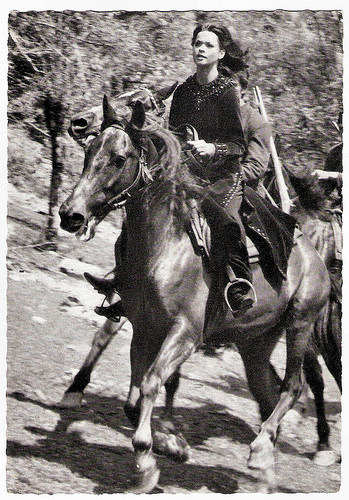
German postcard by Filmbilder-Vertrieb Ernst Freihoff, Essen, no. 921. Retail price: 10 Pfg. Photo: Gloria / Schnelle. Publicity still for Der Schut/The Shoot (Robert Siodmak, 1964) with Marie Versini as Tschita.
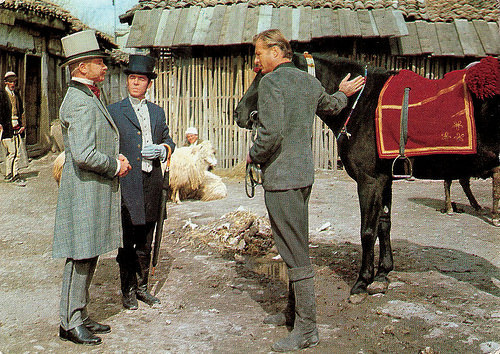
German postcard by Heinerle Karl-May-Postkarten, no. 2. Photo: CCC / Gloria. Publicity still for Der Schut/The Yellow One (Robert Siodmak, 1964) with Dieter Borsche , Chris Howland and Lex Barker . Caption: "Mister Kara, wie gut, dass ich Euch treffe. Euer Freund Galingré wurde von den Banditen des Schut überfallen und entführt. Ein gewisser Nirwan besuchte mich an Bord meiner Jacht und erzählte mir davon.'- 'Unter diesen Umständen kann ich natürlich nicht mit Euch nach Egypten reisen, Sir David, das werdet Ihr verstehen. Ich werde nach Ostromdscha reiten, wo die Frau meines entführten Freundes lebt... Ich muss den Schut finden!'- " (Mister Kara, so good that I meet you. Your friend Galingré was attacked and kidnapped by bandits of the Yellow One. A certain Nirwan visited me on board of my yacht and told me about it .'- 'In these circumstances, I can not travel with you to Egypt of course, Sir David, which will you understand. I will ride to Strumnitza where my kidnapped friend's wife lives ... I need to find the Yellow One'! -)
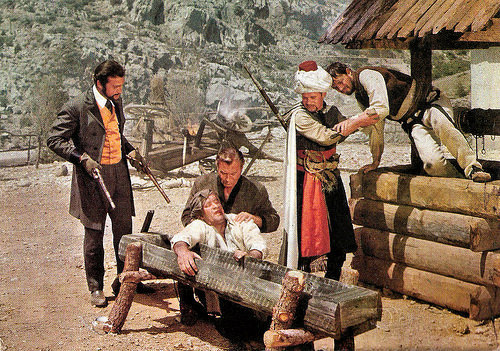
German postcard by Heinerle Karl-May-Postkarten, no. 7. Photo: CCC / Gloria. Publicity still for Der Schut/The Yellow One (Robert Siodmak, 1964). Caption: "Keine Angst, guter Mann. Wir sind Freunde von Dir. Mein Sihdi, der berühmte Kara ben Nemsi und ich werden alles tun, um diesen Schurken, den Schut, zu fangen." (Do not worry, my good man. We are friends of yours. My Sidi, the famous Kara ben Nemsi and I will do everything possible to catch these rogues, the Schut.)
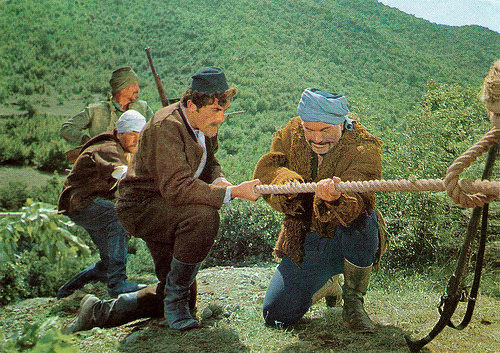
German postcard by Heinerle Karl-May-Postkarten, no. 9. Photo: CCC / Gloria. Publicity still for Der Schut/The Yellow One (Robert Siodmak, 1964) with Renato Baldini. Caption: "'Hier Barud, nimm mein Messer!' - 'Ja, so geht's besser! Sollte jetzt Jemand lust haben, uns zu verfolgen, dann braucht er nur über diese Brücke zu kommen!' - " (Barud, take my knife! '- 'Yes, now it gets better! If someone should like to persecute us, then he just needs to come across the bridge!)
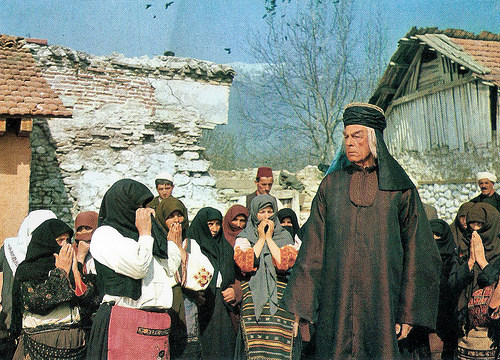
German postcard by Heinerle Karl-May-Postkarten, no. 13. Photo: CCC / Gloria. Publicity still for Der Schut/The Yellow One (Robert Siodmak, 1964) with Friedrich von Ledebur. Caption: "Ich habe solche Angst vor dem Heiligen Mübarek, er wird zornig sein, weil ich mit euch spreche und seine Raben werden ihn sagen, was ich euch erzählt habe... Dass er die Leute vor euch gewarnt hat...!" (I am so afraid of the Holy Mübarek, he will be angry that I speak to you, and his ravens will tell him what I told you ... That he warned the people for you ...!)
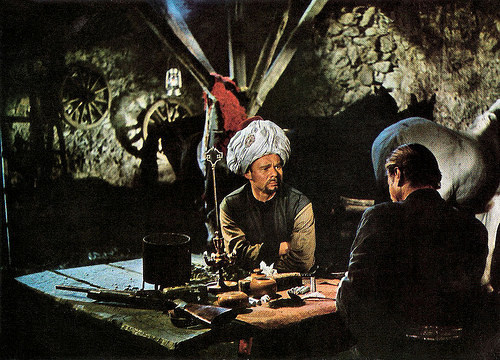
German postcard by Heinerle Karl-May-Postkarten, no. 15. Photo: CCC / Gloria. Publicity still for Der Schut/The Yellow One (Robert Siodmak, 1964). Caption: "Am Abend im Hause Galingré: 'Halef, ich werde dem Mübarek einen Streich spielen. Deshalb musstest du mir Wismut und Quecksilber besorgen. Daraus mache ich Kugeln, die genau aussehen wie Bleikugeln, aber beim Schiessen zerfallen. Nun lade ich das Gewehr immer abwechselnd mit einer Kugel aus Blei und mit einer falschen...'" (In the evening at home Galingré: "Halef, I will play a trick on the Mübarek. Therefore, you had to get me bismuth and mercury. From this I'll make bullets that look like lead bullets, but disintegrate during firing. Now I'll load the gun alternately with a bullet made of lead and a fake one ...")
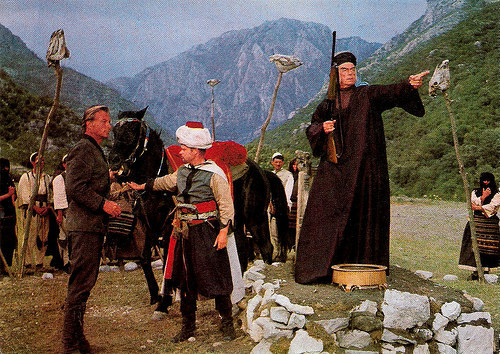
German postcard by Heinerle Karl-May-Postkarten, no. 16. Photo: CCC / Gloria. Publicity still for Der Schut/The Yellow One (Robert Siodmak, 1964) with Lex Barker , Ralf Wolter and Friedrich von Ledebur. Caption: "Der heilige Mübarek stellt sich seinem Gegner, Kara Ben Nemsi. "Dieser blonde Giaur soll dafür bestraft werden, dass er einen heiligen Raben erschossen hat. Es ist Allahs Wille!" - Ihr lügt, Mübarek. Es ist nicht Allah's sondern dein Wille. Du fürchtest dich von mir, weil ich ein grösserer Zauberer bin als du. Ich will es dir beweisen. Hier ist ein Gewehr, das genauer und besser schiesst als jedes andere. Wenn du mich mit einer einzigen Kugel treffen kannst, dann soll es dir gehören, Mübarek. Halef, zeig ihm das Gewehr und wie man damit feuert." (The Holy Mübarek faces his opponent, Kara Ben Nemsi. "This blonde Giaur will be punished because he shot a sacred raven. It is the will of Allah!" - You lie, Mübarek. It is not God's will but yours. You're afraid of me because I am a greater magician than you. I want to prove it to you. Here is a gun that shoots more accurate and better than any other. If you can meet with a single bullet, then it should belong to you, Mübarek. Halef, show him the rifle and how to fire it.)
Heroic Kara Ben Nemsi
The secretive 'Schut' or 'The Yellow One' ( Rik Battaglia ) is a bandit king who terrorizes a whole region in the land of the Skipetars - modern Albanians, one of the few Balkan people who adopted the Turkish Muslim faith. He controls the land in the disguise of the wealthy Persian carpet merchant Nirwan.
The Schut holds an English aristocrat and a French merchant for a ransom, then he also abducts the beautiful Tschita ( Marie Versini ), Kara's friend Omar's fiancée. The corrupt police force does not take any action against him.
Heroic Kara Ben Nemsi (the Turkish-Arabic name means 'black(bearded) German') tries to find the Schut's hiding-place in the mountains and free the prisoners. But the Schut has many rogues and assassins under his command who make this search long and dangerous.
After unmasking the Mübarek, a local phony 'magician', and dealing with some other ruffians and corruption, Kara Ben Nemsi and Lord Lindsay ( Dieter Borsche ) with his butler Archie ( Chris Howland ) set out to finish The Schut off.
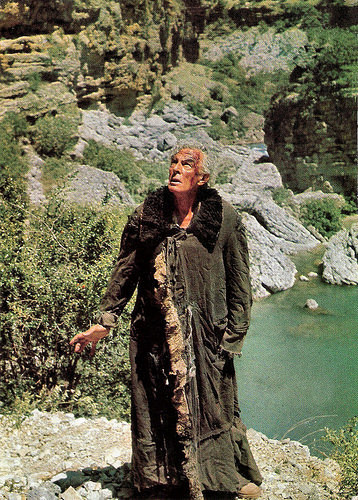
German postcard by Heinerle Karl-May-Postkarten, no. 17. Photo: CCC / Gloria. Publicity still for Der Schut/The Yellow One (Robert Siodmak, 1964). Caption: "Seht ihr, was hinter der Maske dieses Heiligen steckt? Halif hat ihm den Mantel heruntergerissen und hervor kam das zerfetzte Kleid des angeblich lahmen und taubstummen Bettlers Busra. Er war stets überall und nirgends - trotz seiner kranken Beine. Nicht die Raben haben den Mübarek alles erzählt, sondern er selbst hörte was über ihn gesprochen wurde." (Do you see what's behind the mask of this saint? Halif has torn down his coat and forth came the tattered dress of the supposedly lame and deaf-mute beggar Busra. He was always everywhere and nowhere - despite his ill legs. Not the Ravens have told the Mübarek everything, but he could hear himself what was being said about him.)
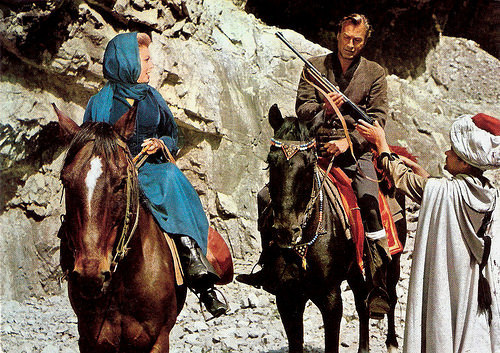
German postcard by Heinerle Karl-May-Postkarten, no. 29. Photo: CCC / Gloria. Publicity still for Der Schut/The Yellow One (Robert Siodmak, 1964) with Marianne Hold and Lex Barker . Caption: "Wie froh bin ich, dass Ihnen nichts passiert ist, Mister Kara. Ich hörte die Schüsse..." - "Wie Sie sehen, ist mit diesem Mübarek alles gut gegangen, Madame Galingré. Fein dass Sie die Pferde mitgebracht haben. Da können Omar, Halef und Ich gleich die Verfolgung des Schut aufnehmen." ("How glad I am that nothing happened to you, Mister Kara ( Lex Barker ). I heard the shots ...." - "As you can see, everything went well with this Mübarek, Madame Galingré ( Marianne Hold ). Fine that you brought the horses. Omar, Halef and I can immediately do on with the persecution of The Yellow One.")
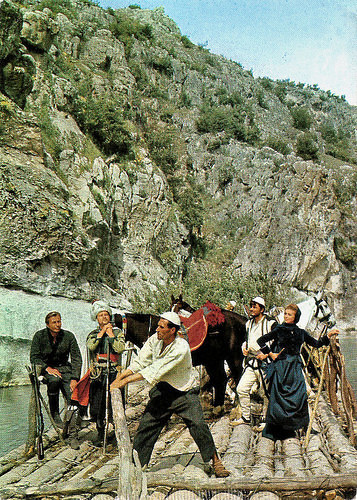
German postcard by Heinerle Karl-May-Postkarten, no. 31. Photo: CCC / Gloria. Publicity still for Der Schut/The Yellow One (Robert Siodmak, 1964) with Lex Barker, Ralf Wolter and Marianne Hold . Caption: "Das vollbeladene Floss. Ein gutes Angriffsziel für die sich in den Felsen versteckt haltenden Banditen." (The fully loaded raft. A good target for the bandits, who are hiding between the rocks.)
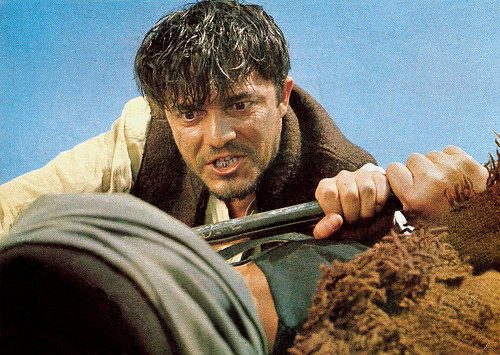
German postcard by Heinerle Karl-May-Postkarten, no. 36. Photo: CCC / Gloria. Publicity still for Der Schut/The Yellow One (Robert Siodmak, 1964) with Dusan Janicijevic. Caption: "Zum letzten Mal! Wo ist meine Braut Tschita? Wohin hast du sie geschleppt?" (For the last time! Where is my bride Tschita? Where did you drag her?)
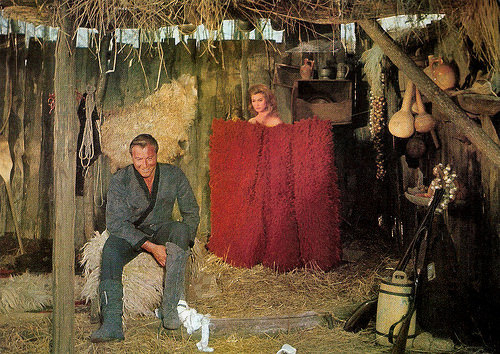
German postcard by Heinerle Karl-May-Postkarten, no. 37. Photo: CCC / Gloria. Publicity still for Der Schut/The Yellow One (Robert Siodmak, 1964) with Lex Barker and Marianne Hold . Caption: "Damit Madame Galingré sich von den Strapazen des Überfalls erholen kann, wird eine kurze Rast eingelegt. Erst am nächsten Morgen soll die Suche nach dem Schut fortgezetst werden." (A short break is inserted, so Madame Galingré can recover from the rigors of the raid. The next morning the search for the Yellow One will be continued.)
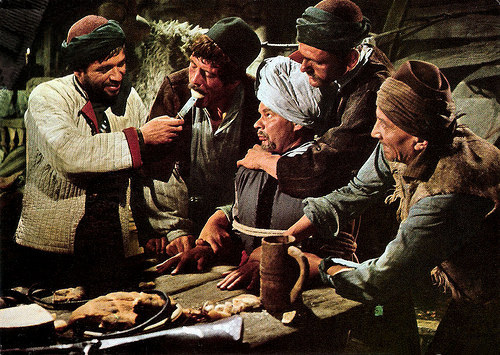
German postcard by Heinerle Karl-May-Postkarten, no. 39. Photo: CCC / Gloria. Publicity still for Der Schut/The Yellow One (Robert Siodmak, 1964) with Ralf Wolter . Caption: "Man hat Halef in die Schluchthütte gerissen und ihn dort gefesselt. 'Wo halt sich Kara auf? Rede... oder!' - Aber Halef schweigt und widersteht alle Drohungen und Schlägen." (They have pulled Halef into the canyon lodge and tied him up there. 'Where is Kara holding on? Speak... or! '- But Halef remains silent and resists all threats and beatings.)
Karl May's Oriental Cycle
Der Schut was not the first adaptation of the Oriental novels with Kara Ben Nemsi by Karl May. In 1920, May's friends Marie Luise Droop and her husband Adolf Droop among others founded in cooperation with the Karl May Press the production company Ustad-Film.
They produced three silent films: Auf den Trümmern des Paradieses/On the Brink of Paradise (Josef Stein, 1920), Die Todeskarawane/Caravan of Death (Josef Stein, 1920) and Die Teufelsanbeter/The Devil Worshippers (Marie Luise Droop, 1920), all starring Carl de Vogt as Kara Ben Nemsi. These three films are believed to be lost. Due to the low success Ustad-Film went bankrupt in the following year.
The first sound film was Durch die Wüste/Through the Desert (J.A. Hübler-Kahla, 1936). Kara Ben Nemsi was played by Fred Raupach.
The German-Spanish Die Sklavenkarawane/Caravan of Slaves (Georg Marischka, Ramón Torrado, 1958) and its sequel Der Löwe von Babylon/The Lion of Babylon (Johannes Kai, Ramón Torrado, 1959) were the first colour films. In the first film, Kara Ben Nemsi was played by Viktor Staal and in the second by Helmuth Schneider . In both films Halef was played by Georg Thomalla and Sir David Lindsay by Theo Lingen .
Famous is the Karl May film wave from 1962–1968, which was one of the most successful German film series ever. Most of these films were made separately by the two competitors Horst Wendlandt and Artur Brauner.
Most of the 17 films of this series were Westerns starring Pierre Brice as Winnetou, beginning with Der Schatz im Silbersee/The Treasure of the Silver Lake (Harald Reinl, 1962).
Three of the films were based on the Orient cycle. After Der Schut followed Durchs wilde Kurdistan/Wild Kurdistan (Franz Josef Gottlieb, 1965) and Im Reiche des silbernen Löwen/Kingdom of the Silver Lion (Franz Josef Gottlieb, 1965). In all three films Lex Barker starred as Kara Ben Nemsi.
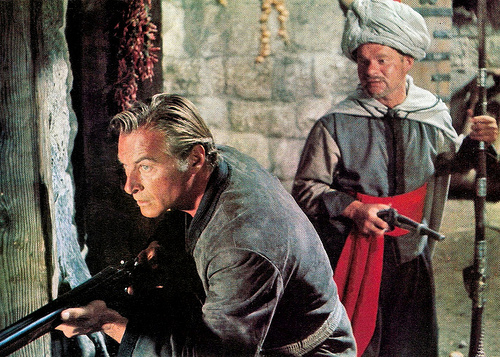
German postcard by Heinerle Karl-May-Postkarten, no. 40. Photo: CCC / Gloria. Publicity still for Der Schut/The Yellow One (Robert Siodmak, 1964) with Lex Barker and Ralf Wolter . Caption: "Kara der seinen treuen Diener plötzlich vermisste, ist seinen Spuren nachgegangen und konnte ihn noch rechtzeitig aus den Klauen der Banditen befreien. Jeder einzelner wird jetzt von Kara mit seinem gefürchteten Bärentöter aufs Korn genommen." (Kara, who suddenly missed his faithful servant, has followed in his footsteps, and could free him in time from the clutches of the bandits. Kara now takes each bandit on the grain with his dreaded bear hunter.)
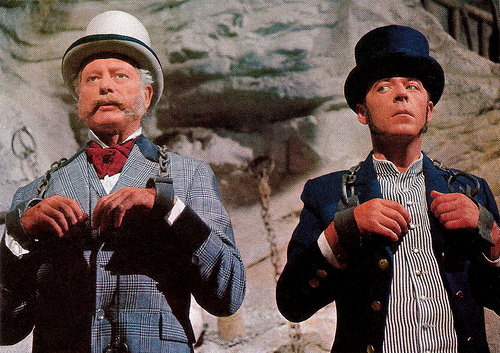
German postcard by Heinerle Karl-May-Postkarten, no. 43. Photo: CCC / Gloria. Publicity still for Der Schut/The Yellow One (Robert Siodmak, 1964) with Dieter Borsche and Chris Howland . Caption: "'Well, Archibald, was nun?' fragt Sir Lindsay seinen Butler, als sie der Schut unversehends in einer Felsenhöhle, die sich unter seinem Palast befindet, gefangensetzt." ('Archibald now what?', Sir Lindsay (Dieter Borsche) asks his butler (Chris Howland), when The Shoot enexpectedly captures them in a cave, which is located beneath his palace." )
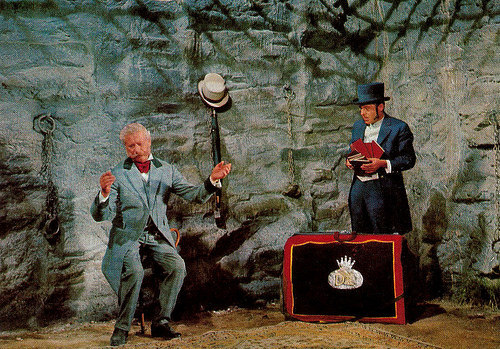
German postcard by Heinerle Karl-May-Postkarten, no. 44. Photo: CCC / Gloria. Publicity still for Der Schut/The Yellow One (Robert Siodmak, 1964) with Dieter Borsche and Chris Howland . Caption: "Der Lord sowie sein Diener lassen sich durch die Situation nicht erschüttern. Archie halt in seinem Wunderkoffer alles bereit, um seinem Lord den Aufenthalt in der Felsenhöhle so angenehm wie möglich zu machen." (The Lord and his servant won't be shaken by the situation. Archie has in his magical suitcase everything ready to make his Lord's stay in the cave as pleasant as possible.)
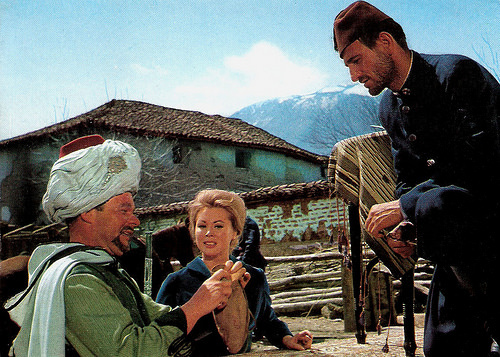
German postcard by Heinerle Karl-May-Postkarten, no. 46. Photo: CCC / Gloria. Publicity still for Der Schut/The Yellow One (Robert Siodmak, 1964) with Ralf Wolter and Marianne Hold . Caption: "Durch eine List gelingt es dem treuen Diener Halef mit Hilfe von türkischen Soldaten seinen geliebten Herrn, Kara Ben Nemsi, aus den Händen des Schut zu befreien, der ihn gefangenhält." (By a ruse and with the help of Turkish soldiers, the faithful servant Halef can free his beloved Lord, Kara Ben Nemsi, from the hands of the Yellow One, who has imprisoned him.)
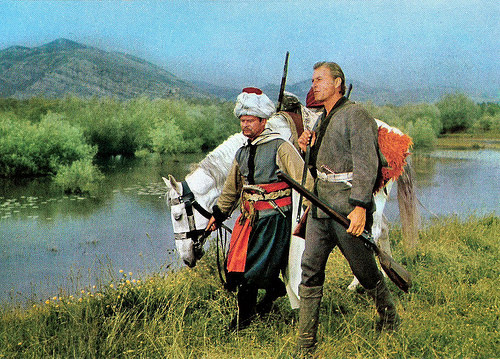
German postcard by Heinerle Karl-May-Postkarten, no. 48. Photo: CCC / Gloria. Publicity still for Der Schut/The Yellow One (Robert Siodmak, 1964). Caption: "Die Abschiedsstunde schlägt. Kara will in seine Heimat zurückkehren. Traurig sagt Halef seinem beliebten Herrn 'Good-bye'. 'Sihdi, wir werden uns wiedersehen, wenn der Sohn von Rih das Licht der Welt erblickt hat!'" (The Farewell Bell Tolls. Kara wants to return to his homeland. Sad Halef says his beloved Lord "Good-bye". "Sidi, we 'll meet again, when the son of Rih has seen the light of day!")
Sources: Wikipedia and IMDb.

German postcard by Filmbilder-Vertrieb Ernst Freihoff, Essen, no. 921. Retail price: 10 Pfg. Photo: Gloria / Schnelle. Publicity still for Der Schut/The Shoot (Robert Siodmak, 1964) with Marie Versini as Tschita.

German postcard by Heinerle Karl-May-Postkarten, no. 2. Photo: CCC / Gloria. Publicity still for Der Schut/The Yellow One (Robert Siodmak, 1964) with Dieter Borsche , Chris Howland and Lex Barker . Caption: "Mister Kara, wie gut, dass ich Euch treffe. Euer Freund Galingré wurde von den Banditen des Schut überfallen und entführt. Ein gewisser Nirwan besuchte mich an Bord meiner Jacht und erzählte mir davon.'- 'Unter diesen Umständen kann ich natürlich nicht mit Euch nach Egypten reisen, Sir David, das werdet Ihr verstehen. Ich werde nach Ostromdscha reiten, wo die Frau meines entführten Freundes lebt... Ich muss den Schut finden!'- " (Mister Kara, so good that I meet you. Your friend Galingré was attacked and kidnapped by bandits of the Yellow One. A certain Nirwan visited me on board of my yacht and told me about it .'- 'In these circumstances, I can not travel with you to Egypt of course, Sir David, which will you understand. I will ride to Strumnitza where my kidnapped friend's wife lives ... I need to find the Yellow One'! -)

German postcard by Heinerle Karl-May-Postkarten, no. 7. Photo: CCC / Gloria. Publicity still for Der Schut/The Yellow One (Robert Siodmak, 1964). Caption: "Keine Angst, guter Mann. Wir sind Freunde von Dir. Mein Sihdi, der berühmte Kara ben Nemsi und ich werden alles tun, um diesen Schurken, den Schut, zu fangen." (Do not worry, my good man. We are friends of yours. My Sidi, the famous Kara ben Nemsi and I will do everything possible to catch these rogues, the Schut.)

German postcard by Heinerle Karl-May-Postkarten, no. 9. Photo: CCC / Gloria. Publicity still for Der Schut/The Yellow One (Robert Siodmak, 1964) with Renato Baldini. Caption: "'Hier Barud, nimm mein Messer!' - 'Ja, so geht's besser! Sollte jetzt Jemand lust haben, uns zu verfolgen, dann braucht er nur über diese Brücke zu kommen!' - " (Barud, take my knife! '- 'Yes, now it gets better! If someone should like to persecute us, then he just needs to come across the bridge!)

German postcard by Heinerle Karl-May-Postkarten, no. 13. Photo: CCC / Gloria. Publicity still for Der Schut/The Yellow One (Robert Siodmak, 1964) with Friedrich von Ledebur. Caption: "Ich habe solche Angst vor dem Heiligen Mübarek, er wird zornig sein, weil ich mit euch spreche und seine Raben werden ihn sagen, was ich euch erzählt habe... Dass er die Leute vor euch gewarnt hat...!" (I am so afraid of the Holy Mübarek, he will be angry that I speak to you, and his ravens will tell him what I told you ... That he warned the people for you ...!)

German postcard by Heinerle Karl-May-Postkarten, no. 15. Photo: CCC / Gloria. Publicity still for Der Schut/The Yellow One (Robert Siodmak, 1964). Caption: "Am Abend im Hause Galingré: 'Halef, ich werde dem Mübarek einen Streich spielen. Deshalb musstest du mir Wismut und Quecksilber besorgen. Daraus mache ich Kugeln, die genau aussehen wie Bleikugeln, aber beim Schiessen zerfallen. Nun lade ich das Gewehr immer abwechselnd mit einer Kugel aus Blei und mit einer falschen...'" (In the evening at home Galingré: "Halef, I will play a trick on the Mübarek. Therefore, you had to get me bismuth and mercury. From this I'll make bullets that look like lead bullets, but disintegrate during firing. Now I'll load the gun alternately with a bullet made of lead and a fake one ...")

German postcard by Heinerle Karl-May-Postkarten, no. 16. Photo: CCC / Gloria. Publicity still for Der Schut/The Yellow One (Robert Siodmak, 1964) with Lex Barker , Ralf Wolter and Friedrich von Ledebur. Caption: "Der heilige Mübarek stellt sich seinem Gegner, Kara Ben Nemsi. "Dieser blonde Giaur soll dafür bestraft werden, dass er einen heiligen Raben erschossen hat. Es ist Allahs Wille!" - Ihr lügt, Mübarek. Es ist nicht Allah's sondern dein Wille. Du fürchtest dich von mir, weil ich ein grösserer Zauberer bin als du. Ich will es dir beweisen. Hier ist ein Gewehr, das genauer und besser schiesst als jedes andere. Wenn du mich mit einer einzigen Kugel treffen kannst, dann soll es dir gehören, Mübarek. Halef, zeig ihm das Gewehr und wie man damit feuert." (The Holy Mübarek faces his opponent, Kara Ben Nemsi. "This blonde Giaur will be punished because he shot a sacred raven. It is the will of Allah!" - You lie, Mübarek. It is not God's will but yours. You're afraid of me because I am a greater magician than you. I want to prove it to you. Here is a gun that shoots more accurate and better than any other. If you can meet with a single bullet, then it should belong to you, Mübarek. Halef, show him the rifle and how to fire it.)
Heroic Kara Ben Nemsi
The secretive 'Schut' or 'The Yellow One' ( Rik Battaglia ) is a bandit king who terrorizes a whole region in the land of the Skipetars - modern Albanians, one of the few Balkan people who adopted the Turkish Muslim faith. He controls the land in the disguise of the wealthy Persian carpet merchant Nirwan.
The Schut holds an English aristocrat and a French merchant for a ransom, then he also abducts the beautiful Tschita ( Marie Versini ), Kara's friend Omar's fiancée. The corrupt police force does not take any action against him.
Heroic Kara Ben Nemsi (the Turkish-Arabic name means 'black(bearded) German') tries to find the Schut's hiding-place in the mountains and free the prisoners. But the Schut has many rogues and assassins under his command who make this search long and dangerous.
After unmasking the Mübarek, a local phony 'magician', and dealing with some other ruffians and corruption, Kara Ben Nemsi and Lord Lindsay ( Dieter Borsche ) with his butler Archie ( Chris Howland ) set out to finish The Schut off.

German postcard by Heinerle Karl-May-Postkarten, no. 17. Photo: CCC / Gloria. Publicity still for Der Schut/The Yellow One (Robert Siodmak, 1964). Caption: "Seht ihr, was hinter der Maske dieses Heiligen steckt? Halif hat ihm den Mantel heruntergerissen und hervor kam das zerfetzte Kleid des angeblich lahmen und taubstummen Bettlers Busra. Er war stets überall und nirgends - trotz seiner kranken Beine. Nicht die Raben haben den Mübarek alles erzählt, sondern er selbst hörte was über ihn gesprochen wurde." (Do you see what's behind the mask of this saint? Halif has torn down his coat and forth came the tattered dress of the supposedly lame and deaf-mute beggar Busra. He was always everywhere and nowhere - despite his ill legs. Not the Ravens have told the Mübarek everything, but he could hear himself what was being said about him.)

German postcard by Heinerle Karl-May-Postkarten, no. 29. Photo: CCC / Gloria. Publicity still for Der Schut/The Yellow One (Robert Siodmak, 1964) with Marianne Hold and Lex Barker . Caption: "Wie froh bin ich, dass Ihnen nichts passiert ist, Mister Kara. Ich hörte die Schüsse..." - "Wie Sie sehen, ist mit diesem Mübarek alles gut gegangen, Madame Galingré. Fein dass Sie die Pferde mitgebracht haben. Da können Omar, Halef und Ich gleich die Verfolgung des Schut aufnehmen." ("How glad I am that nothing happened to you, Mister Kara ( Lex Barker ). I heard the shots ...." - "As you can see, everything went well with this Mübarek, Madame Galingré ( Marianne Hold ). Fine that you brought the horses. Omar, Halef and I can immediately do on with the persecution of The Yellow One.")

German postcard by Heinerle Karl-May-Postkarten, no. 31. Photo: CCC / Gloria. Publicity still for Der Schut/The Yellow One (Robert Siodmak, 1964) with Lex Barker, Ralf Wolter and Marianne Hold . Caption: "Das vollbeladene Floss. Ein gutes Angriffsziel für die sich in den Felsen versteckt haltenden Banditen." (The fully loaded raft. A good target for the bandits, who are hiding between the rocks.)

German postcard by Heinerle Karl-May-Postkarten, no. 36. Photo: CCC / Gloria. Publicity still for Der Schut/The Yellow One (Robert Siodmak, 1964) with Dusan Janicijevic. Caption: "Zum letzten Mal! Wo ist meine Braut Tschita? Wohin hast du sie geschleppt?" (For the last time! Where is my bride Tschita? Where did you drag her?)

German postcard by Heinerle Karl-May-Postkarten, no. 37. Photo: CCC / Gloria. Publicity still for Der Schut/The Yellow One (Robert Siodmak, 1964) with Lex Barker and Marianne Hold . Caption: "Damit Madame Galingré sich von den Strapazen des Überfalls erholen kann, wird eine kurze Rast eingelegt. Erst am nächsten Morgen soll die Suche nach dem Schut fortgezetst werden." (A short break is inserted, so Madame Galingré can recover from the rigors of the raid. The next morning the search for the Yellow One will be continued.)

German postcard by Heinerle Karl-May-Postkarten, no. 39. Photo: CCC / Gloria. Publicity still for Der Schut/The Yellow One (Robert Siodmak, 1964) with Ralf Wolter . Caption: "Man hat Halef in die Schluchthütte gerissen und ihn dort gefesselt. 'Wo halt sich Kara auf? Rede... oder!' - Aber Halef schweigt und widersteht alle Drohungen und Schlägen." (They have pulled Halef into the canyon lodge and tied him up there. 'Where is Kara holding on? Speak... or! '- But Halef remains silent and resists all threats and beatings.)
Karl May's Oriental Cycle
Der Schut was not the first adaptation of the Oriental novels with Kara Ben Nemsi by Karl May. In 1920, May's friends Marie Luise Droop and her husband Adolf Droop among others founded in cooperation with the Karl May Press the production company Ustad-Film.
They produced three silent films: Auf den Trümmern des Paradieses/On the Brink of Paradise (Josef Stein, 1920), Die Todeskarawane/Caravan of Death (Josef Stein, 1920) and Die Teufelsanbeter/The Devil Worshippers (Marie Luise Droop, 1920), all starring Carl de Vogt as Kara Ben Nemsi. These three films are believed to be lost. Due to the low success Ustad-Film went bankrupt in the following year.
The first sound film was Durch die Wüste/Through the Desert (J.A. Hübler-Kahla, 1936). Kara Ben Nemsi was played by Fred Raupach.
The German-Spanish Die Sklavenkarawane/Caravan of Slaves (Georg Marischka, Ramón Torrado, 1958) and its sequel Der Löwe von Babylon/The Lion of Babylon (Johannes Kai, Ramón Torrado, 1959) were the first colour films. In the first film, Kara Ben Nemsi was played by Viktor Staal and in the second by Helmuth Schneider . In both films Halef was played by Georg Thomalla and Sir David Lindsay by Theo Lingen .
Famous is the Karl May film wave from 1962–1968, which was one of the most successful German film series ever. Most of these films were made separately by the two competitors Horst Wendlandt and Artur Brauner.
Most of the 17 films of this series were Westerns starring Pierre Brice as Winnetou, beginning with Der Schatz im Silbersee/The Treasure of the Silver Lake (Harald Reinl, 1962).
Three of the films were based on the Orient cycle. After Der Schut followed Durchs wilde Kurdistan/Wild Kurdistan (Franz Josef Gottlieb, 1965) and Im Reiche des silbernen Löwen/Kingdom of the Silver Lion (Franz Josef Gottlieb, 1965). In all three films Lex Barker starred as Kara Ben Nemsi.

German postcard by Heinerle Karl-May-Postkarten, no. 40. Photo: CCC / Gloria. Publicity still for Der Schut/The Yellow One (Robert Siodmak, 1964) with Lex Barker and Ralf Wolter . Caption: "Kara der seinen treuen Diener plötzlich vermisste, ist seinen Spuren nachgegangen und konnte ihn noch rechtzeitig aus den Klauen der Banditen befreien. Jeder einzelner wird jetzt von Kara mit seinem gefürchteten Bärentöter aufs Korn genommen." (Kara, who suddenly missed his faithful servant, has followed in his footsteps, and could free him in time from the clutches of the bandits. Kara now takes each bandit on the grain with his dreaded bear hunter.)

German postcard by Heinerle Karl-May-Postkarten, no. 43. Photo: CCC / Gloria. Publicity still for Der Schut/The Yellow One (Robert Siodmak, 1964) with Dieter Borsche and Chris Howland . Caption: "'Well, Archibald, was nun?' fragt Sir Lindsay seinen Butler, als sie der Schut unversehends in einer Felsenhöhle, die sich unter seinem Palast befindet, gefangensetzt." ('Archibald now what?', Sir Lindsay (Dieter Borsche) asks his butler (Chris Howland), when The Shoot enexpectedly captures them in a cave, which is located beneath his palace." )

German postcard by Heinerle Karl-May-Postkarten, no. 44. Photo: CCC / Gloria. Publicity still for Der Schut/The Yellow One (Robert Siodmak, 1964) with Dieter Borsche and Chris Howland . Caption: "Der Lord sowie sein Diener lassen sich durch die Situation nicht erschüttern. Archie halt in seinem Wunderkoffer alles bereit, um seinem Lord den Aufenthalt in der Felsenhöhle so angenehm wie möglich zu machen." (The Lord and his servant won't be shaken by the situation. Archie has in his magical suitcase everything ready to make his Lord's stay in the cave as pleasant as possible.)

German postcard by Heinerle Karl-May-Postkarten, no. 46. Photo: CCC / Gloria. Publicity still for Der Schut/The Yellow One (Robert Siodmak, 1964) with Ralf Wolter and Marianne Hold . Caption: "Durch eine List gelingt es dem treuen Diener Halef mit Hilfe von türkischen Soldaten seinen geliebten Herrn, Kara Ben Nemsi, aus den Händen des Schut zu befreien, der ihn gefangenhält." (By a ruse and with the help of Turkish soldiers, the faithful servant Halef can free his beloved Lord, Kara Ben Nemsi, from the hands of the Yellow One, who has imprisoned him.)

German postcard by Heinerle Karl-May-Postkarten, no. 48. Photo: CCC / Gloria. Publicity still for Der Schut/The Yellow One (Robert Siodmak, 1964). Caption: "Die Abschiedsstunde schlägt. Kara will in seine Heimat zurückkehren. Traurig sagt Halef seinem beliebten Herrn 'Good-bye'. 'Sihdi, wir werden uns wiedersehen, wenn der Sohn von Rih das Licht der Welt erblickt hat!'" (The Farewell Bell Tolls. Kara wants to return to his homeland. Sad Halef says his beloved Lord "Good-bye". "Sidi, we 'll meet again, when the son of Rih has seen the light of day!")
Sources: Wikipedia and IMDb.
Published on August 14, 2015 22:00
August 13, 2015
Gaby André
French actress Gaby André (1920-1972) was a film star during World War II, who later became the mother of another gorgeous French film star, Carole André.
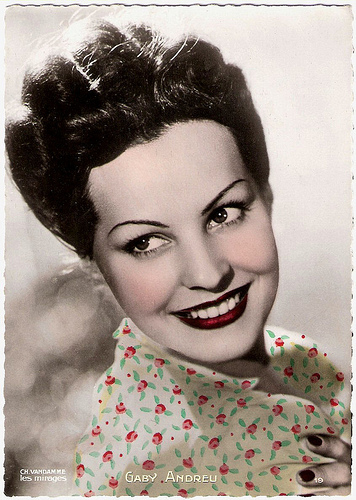
French postcard by Editions P.I., Paris, no. 19. Sent by mail in 1944. Photo: Ch. Vandamme / Les Mirages.
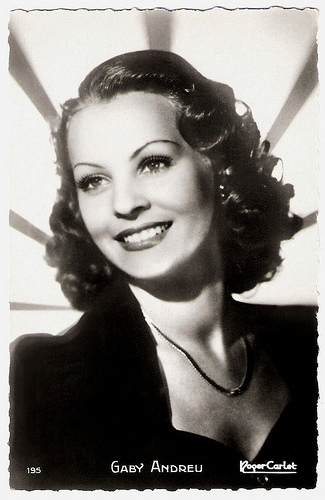
French postcard by Editions P.I., Paris, no. 195. Photo: Roger Carlet.
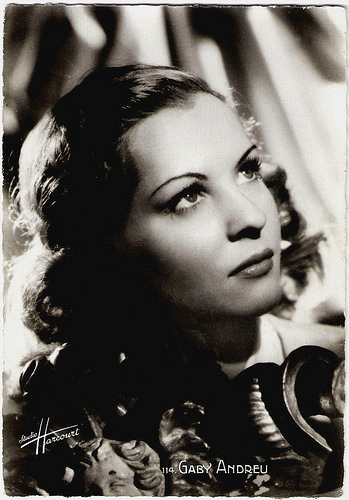
French postcard by Greff Editeur, Paris, no. 114. Photo: Studio Harcourt.
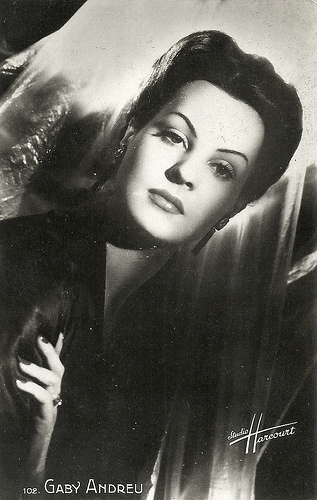
French postcard, no. 102. Photo: Studio Harcourt.
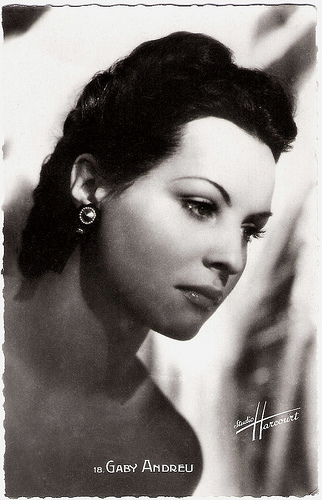
French postcard by SERP, Paris, no. 18. Photo: Studio Harcourt.
Angel of the Night
Gaby André or Gaby Andreu was born as Gabrielle Louise Mathilde Andreu in Chalons-sur-Marne, France, in 1920.
Her film debut was a bit part in Hélène (Jean Benoît-Lévy, Marie Epstein, 1936), based on a novel by Vicky Baum and starring Madeleine Renaud . More small parts followed for the beautiful young actress in Entrée des artistes/The Curtain Rises (Marc Allégret, 1938) with screen legend Louis Jouvet , Le drame de Shanghaï/The Shanghai Drama (Georg Wilhelm Pabst, 1938) again with Jouvet, and La fin du jour/The End of the Day (Julien Duvivier, 1939), an excellent drama about an old people's home for actors.
Her first leading roles were in the limited shown Départ à zéro (Maurice Cloche, 1941-1943) and La maison des sept jeunes filles/The House of the Seven Young Girls (Albert Valentin, 1942), based on a novel by Georges Siménon.
More films followed like the comedy Adémaï bandit d'honneur (Gilles Grangier, 1943) with Noël-Noël , Un seul amour/Secrets of a Ballerina (Pierre Blanchar, 1943), and L’Ange de la nuit/Angel of the Night (André Berthomieu, 1944), starring Jean-Louis Barrault .
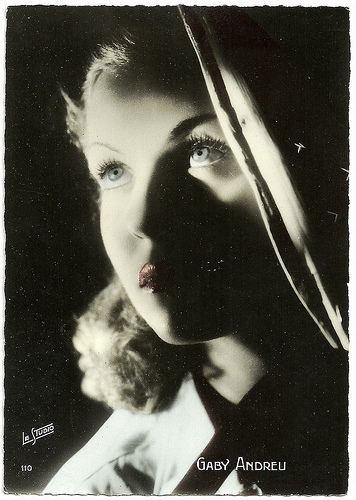
French postcard by Editions O.P., Paris, no. 110. Photo: Le Studio.
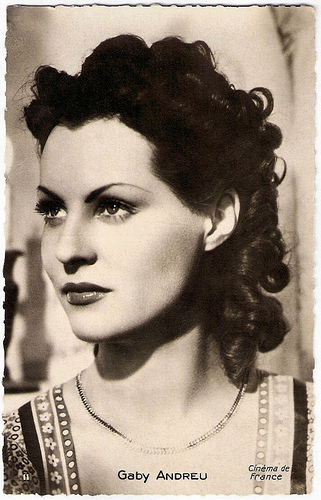
French postcard by Editions E.C., Paris, no. 11. Photo: Cinéma de France.
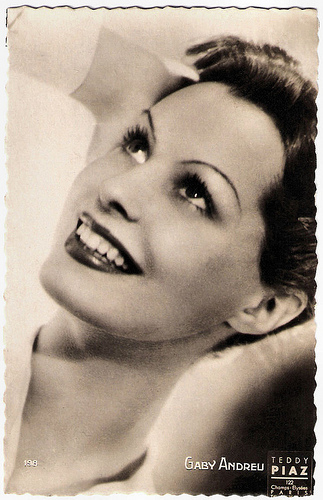
French postcard by Editions O.P., Paris, no. 198. Photo: Teddy Piaz, Paris.
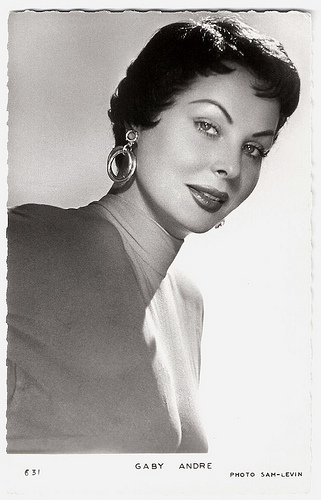
French postcard by Editions P.I., Paris, no. 631, presented by Les Carbones Korès 'Carboplane'. Photo: Sam Lévin.

Italian postcard by B.F.F. Edit, no. 2893. Photo: Dear Film. Publicity still for Prima di sera/Before nightfall (Piero Tellini, 1954).
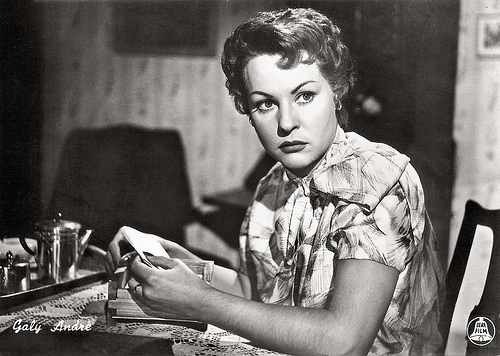
Italian postcard by Bromofoto, Milano, no. 131. Photo: Dear Film. Publicity still for Prima di sera/Before nightfall (Piero Tellini, 1954).
Dreadful Comedy
After the war there was a hiatus in the career of Gaby André. In 1947 she married the American industrialist Eli Smith and they had a daughter, the later actress Carole André. In 1950 she was seen in American films like the comedy Please Believe Me (Norman Taurog, 1950) with Deborah Kerr , and the gangster film Highway 301 (Andrew L. Stone, 1950) starring Steve Cochran.
She returned to France, where she co-starred with Fernandel in the comedy Boniface somnambule/The Sleepwalker (Maurice Labro, 1951). The following years she was seen in international films like The Green Glove (Rudolph Maté, 1952) with Glenn Ford, and Prima di sera/Before the evening (Piero Tellini, 1953), with Paolo Stoppa .
She stayed in Italy for the rest of her life. Among her Italian films were the biopic Giuseppe Verdi/The Life and Music of Giuseppe Verdi (Raffaello Matarazzo, 1953), Donatella (Mario Monicelli, 1956), and the sword and sandal epic La vendetta di Ercole/Goliath and the Dragon (Vittorio Cottafavi, 1960).
Incidentally she appeared in French films like the actioner Incognito (Patrice Dally, 1958) with Eddie Constantine . She played a computer expert in the British Science-Fiction film The Strange World of Planet X/The Cosmic Monsters (Gilbert Gunn, 1958) and a research scientist in the Italian adventure La Granda Caccia/East of Kilimanjaro (Arnold Belgard, Eduardo Capolino, 1957-1959).
Together with her daughter Carole André she starred in Togli le gambe dal parabrezza/You remove the legs from the windscreen (Massimo Franciosa, 1969). Gaby’s final role was in the dreadful comedy Pussycat, Pussycat, I Love You (Rodney Amateau, 1970), the defunct sequel to What’s new Pussycat? (Clive Donner, Richard Talmadge, 1965). Script writer Woody Allen disowns both movies, though.
Gaby André died of cancer in 1972 in Rome, at the age of 52.
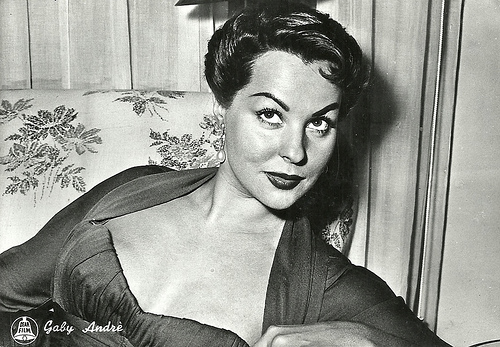
Italian postcard by Bromofoto, Milan, no. 813. Photo: Dear Film.
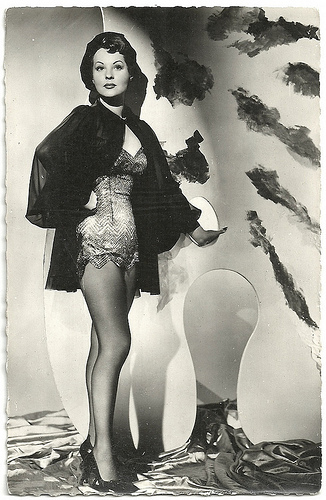
French postcard by Editions du Globe.
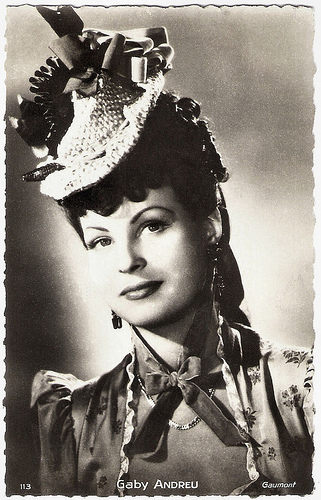
French postcard, no. 113. Photo: Gaumont.
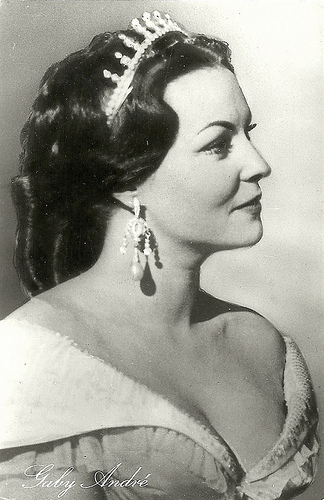
East-German postcard by VEB Progress Film-Vertrieb, no. 935. Photo: publicity still for Giuseppe Verdi (Raffaello Matarazzo, 1953), featuring Pierre Cressoy as Verdi.
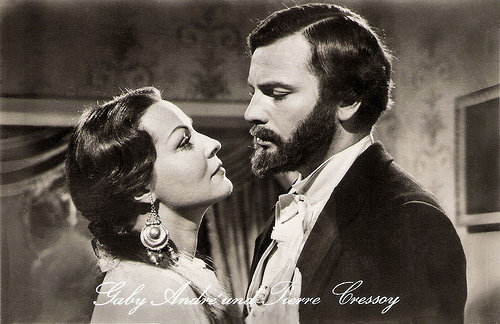
German postcard by VEB Progress Film-Vertrieb, Berlin, no. 934, 1958. Photo: publicity still for Giuseppe Verdi (Raffaello Matarazzo, 1953) featuring Pierre Cressoy as Verdi.
Sources: AllMovie, Cinemémorial (French), Wikipedia (French) and .

French postcard by Editions P.I., Paris, no. 19. Sent by mail in 1944. Photo: Ch. Vandamme / Les Mirages.

French postcard by Editions P.I., Paris, no. 195. Photo: Roger Carlet.

French postcard by Greff Editeur, Paris, no. 114. Photo: Studio Harcourt.

French postcard, no. 102. Photo: Studio Harcourt.

French postcard by SERP, Paris, no. 18. Photo: Studio Harcourt.
Angel of the Night
Gaby André or Gaby Andreu was born as Gabrielle Louise Mathilde Andreu in Chalons-sur-Marne, France, in 1920.
Her film debut was a bit part in Hélène (Jean Benoît-Lévy, Marie Epstein, 1936), based on a novel by Vicky Baum and starring Madeleine Renaud . More small parts followed for the beautiful young actress in Entrée des artistes/The Curtain Rises (Marc Allégret, 1938) with screen legend Louis Jouvet , Le drame de Shanghaï/The Shanghai Drama (Georg Wilhelm Pabst, 1938) again with Jouvet, and La fin du jour/The End of the Day (Julien Duvivier, 1939), an excellent drama about an old people's home for actors.
Her first leading roles were in the limited shown Départ à zéro (Maurice Cloche, 1941-1943) and La maison des sept jeunes filles/The House of the Seven Young Girls (Albert Valentin, 1942), based on a novel by Georges Siménon.
More films followed like the comedy Adémaï bandit d'honneur (Gilles Grangier, 1943) with Noël-Noël , Un seul amour/Secrets of a Ballerina (Pierre Blanchar, 1943), and L’Ange de la nuit/Angel of the Night (André Berthomieu, 1944), starring Jean-Louis Barrault .

French postcard by Editions O.P., Paris, no. 110. Photo: Le Studio.

French postcard by Editions E.C., Paris, no. 11. Photo: Cinéma de France.

French postcard by Editions O.P., Paris, no. 198. Photo: Teddy Piaz, Paris.

French postcard by Editions P.I., Paris, no. 631, presented by Les Carbones Korès 'Carboplane'. Photo: Sam Lévin.

Italian postcard by B.F.F. Edit, no. 2893. Photo: Dear Film. Publicity still for Prima di sera/Before nightfall (Piero Tellini, 1954).

Italian postcard by Bromofoto, Milano, no. 131. Photo: Dear Film. Publicity still for Prima di sera/Before nightfall (Piero Tellini, 1954).
Dreadful Comedy
After the war there was a hiatus in the career of Gaby André. In 1947 she married the American industrialist Eli Smith and they had a daughter, the later actress Carole André. In 1950 she was seen in American films like the comedy Please Believe Me (Norman Taurog, 1950) with Deborah Kerr , and the gangster film Highway 301 (Andrew L. Stone, 1950) starring Steve Cochran.
She returned to France, where she co-starred with Fernandel in the comedy Boniface somnambule/The Sleepwalker (Maurice Labro, 1951). The following years she was seen in international films like The Green Glove (Rudolph Maté, 1952) with Glenn Ford, and Prima di sera/Before the evening (Piero Tellini, 1953), with Paolo Stoppa .
She stayed in Italy for the rest of her life. Among her Italian films were the biopic Giuseppe Verdi/The Life and Music of Giuseppe Verdi (Raffaello Matarazzo, 1953), Donatella (Mario Monicelli, 1956), and the sword and sandal epic La vendetta di Ercole/Goliath and the Dragon (Vittorio Cottafavi, 1960).
Incidentally she appeared in French films like the actioner Incognito (Patrice Dally, 1958) with Eddie Constantine . She played a computer expert in the British Science-Fiction film The Strange World of Planet X/The Cosmic Monsters (Gilbert Gunn, 1958) and a research scientist in the Italian adventure La Granda Caccia/East of Kilimanjaro (Arnold Belgard, Eduardo Capolino, 1957-1959).
Together with her daughter Carole André she starred in Togli le gambe dal parabrezza/You remove the legs from the windscreen (Massimo Franciosa, 1969). Gaby’s final role was in the dreadful comedy Pussycat, Pussycat, I Love You (Rodney Amateau, 1970), the defunct sequel to What’s new Pussycat? (Clive Donner, Richard Talmadge, 1965). Script writer Woody Allen disowns both movies, though.
Gaby André died of cancer in 1972 in Rome, at the age of 52.

Italian postcard by Bromofoto, Milan, no. 813. Photo: Dear Film.

French postcard by Editions du Globe.

French postcard, no. 113. Photo: Gaumont.

East-German postcard by VEB Progress Film-Vertrieb, no. 935. Photo: publicity still for Giuseppe Verdi (Raffaello Matarazzo, 1953), featuring Pierre Cressoy as Verdi.

German postcard by VEB Progress Film-Vertrieb, Berlin, no. 934, 1958. Photo: publicity still for Giuseppe Verdi (Raffaello Matarazzo, 1953) featuring Pierre Cressoy as Verdi.
Sources: AllMovie, Cinemémorial (French), Wikipedia (French) and .
Published on August 13, 2015 22:00
August 12, 2015
New rare postcards from Mother Russia
Yesterday, there was mail from Spain. My friend, collector Didier Hanson sent me scans of his newest acquisitions. For this post I have selected 12 Russian and one Croatian postcards from stars of the pre-Soviet era. Enjoy these rare and wonderful cards, produced for that new and exciting phenomenon, the cinema of the Russian Empire, and for those legendary giants of the Russian stage of a century ago...
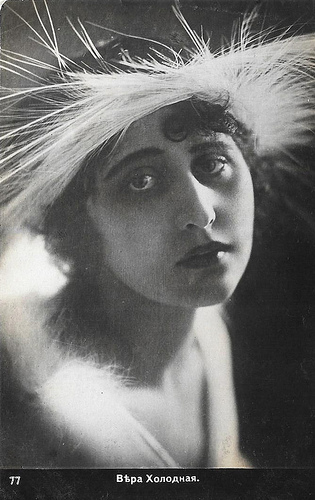
Vera Kholodnaya . Russian postcard, no. 77. Collection: Didier Hanson.

Vera Karalli . Russian Postcard, no. 91, 1917. Collection: Didier Hanson.
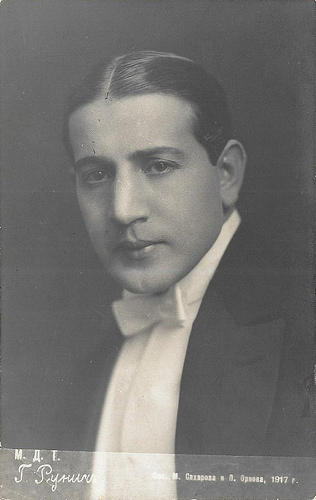
Ossip Runitsch . Russian postcard, 1917. Collection: Didier Hanson.
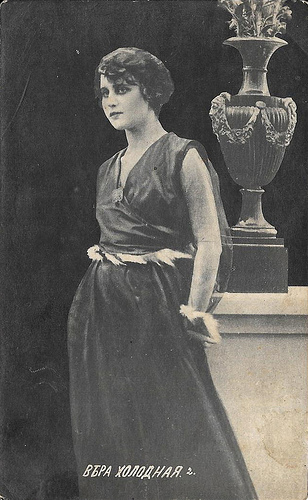
Vera Kholodnaya . Russian postcard, no. 2. Collection: Didier Hanson.

Lidia Ryndina, Vera Karalli and Vitold Polonsky in Vozmezdie (1916). Russian Postcard, no. 152. Collection: Didier Hanson. Photo: publicity still for Vozmezdie/Retribution (Yevgeni Bauer, 1916).
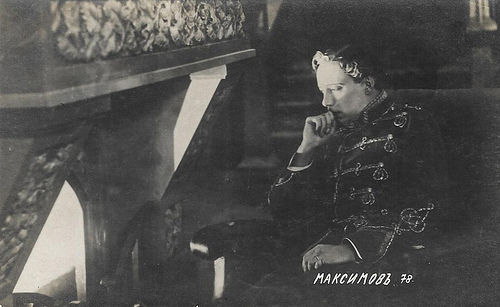
Vladimir Maksimov . Russian postcard, no. 78. Collection: Didier Hanson.
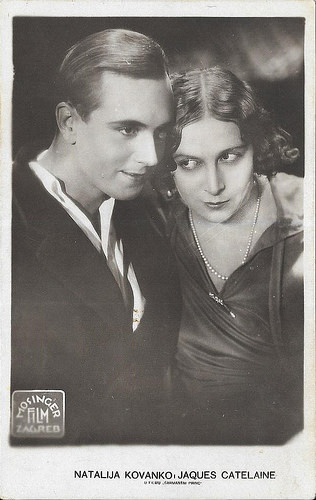
Croatian postcard by Mosinger Film, Zagreb. Collection: Didier Hanson. Jaque Catelain and Nathalie Kovanko played together in Le prince charmant/Prince Charming (Viktor Tourjansky, 1925).
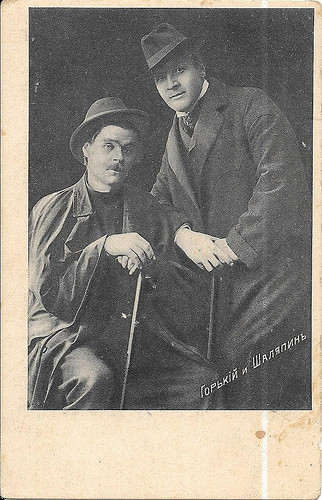
Maxim Gorky and Feodor Chaliapin. Russian postcard. Collection: Didier Hanson.
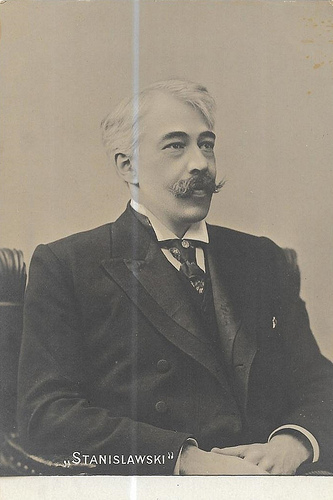
Konstantin Stanislavski. Russian postcard. Collection: Didier Hanson.
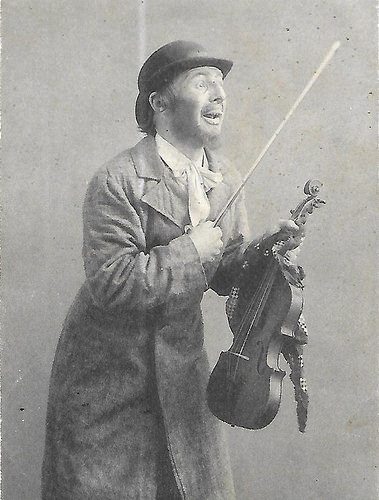
The character of the Jewish violonist Leibke in the play Anathema by Leonid Andreyev. Russian postcard. Collection: Didier Hanson.
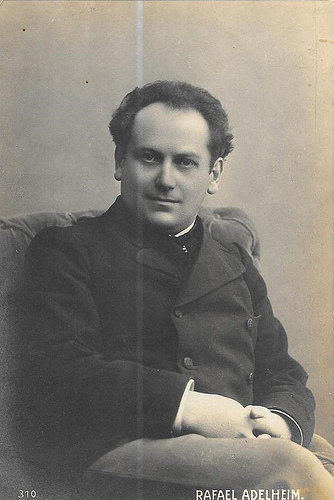
Russian postcard, no. 310. Collection: Didier Hanson. Raphael Adelheim was one of the great actors of the Russian theatre, known for his Shakespeare interpretations. The Jewish actor also played in the silent biopic Leya Lifshitz (Ladislaw Starewicz, 1917). In 1938, he was named People's artist of the republic.
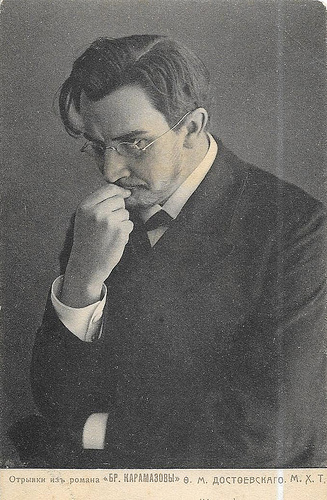
Vasily Kachalov as Ivan in the play The Brothers Karamazov by Fyodor Dostoevsky. Russian postcard. Collection: Didier Hanson.
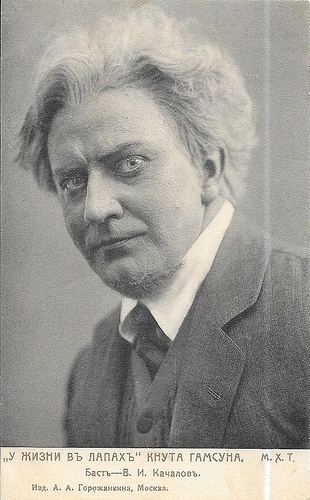
Vasily Kachalov in the play In Life's Clutches (1911) by Knut Hamsun. Russian postcard. Collection: Didier Hanson.
Earlier posts about the collection of Didier Hanson were Rare postcards from the Cinema of the Russian Empire and New rare postcards from the Cinema of the Russian Empire. Thanks, Didier!

Vera Kholodnaya . Russian postcard, no. 77. Collection: Didier Hanson.

Vera Karalli . Russian Postcard, no. 91, 1917. Collection: Didier Hanson.

Ossip Runitsch . Russian postcard, 1917. Collection: Didier Hanson.

Vera Kholodnaya . Russian postcard, no. 2. Collection: Didier Hanson.

Lidia Ryndina, Vera Karalli and Vitold Polonsky in Vozmezdie (1916). Russian Postcard, no. 152. Collection: Didier Hanson. Photo: publicity still for Vozmezdie/Retribution (Yevgeni Bauer, 1916).

Vladimir Maksimov . Russian postcard, no. 78. Collection: Didier Hanson.

Croatian postcard by Mosinger Film, Zagreb. Collection: Didier Hanson. Jaque Catelain and Nathalie Kovanko played together in Le prince charmant/Prince Charming (Viktor Tourjansky, 1925).

Maxim Gorky and Feodor Chaliapin. Russian postcard. Collection: Didier Hanson.

Konstantin Stanislavski. Russian postcard. Collection: Didier Hanson.

The character of the Jewish violonist Leibke in the play Anathema by Leonid Andreyev. Russian postcard. Collection: Didier Hanson.

Russian postcard, no. 310. Collection: Didier Hanson. Raphael Adelheim was one of the great actors of the Russian theatre, known for his Shakespeare interpretations. The Jewish actor also played in the silent biopic Leya Lifshitz (Ladislaw Starewicz, 1917). In 1938, he was named People's artist of the republic.

Vasily Kachalov as Ivan in the play The Brothers Karamazov by Fyodor Dostoevsky. Russian postcard. Collection: Didier Hanson.

Vasily Kachalov in the play In Life's Clutches (1911) by Knut Hamsun. Russian postcard. Collection: Didier Hanson.
Earlier posts about the collection of Didier Hanson were Rare postcards from the Cinema of the Russian Empire and New rare postcards from the Cinema of the Russian Empire. Thanks, Didier!
Published on August 12, 2015 22:00
Paul van Yperen's Blog
- Paul van Yperen's profile
- 13 followers
Paul van Yperen isn't a Goodreads Author
(yet),
but they
do have a blog,
so here are some recent posts imported from
their feed.



